Ritron RIT16-146 VHF-FM Base Transceiver User Manual 14500036 030303 p65
Ritron Inc VHF-FM Base Transceiver 14500036 030303 p65
Ritron >
users manual
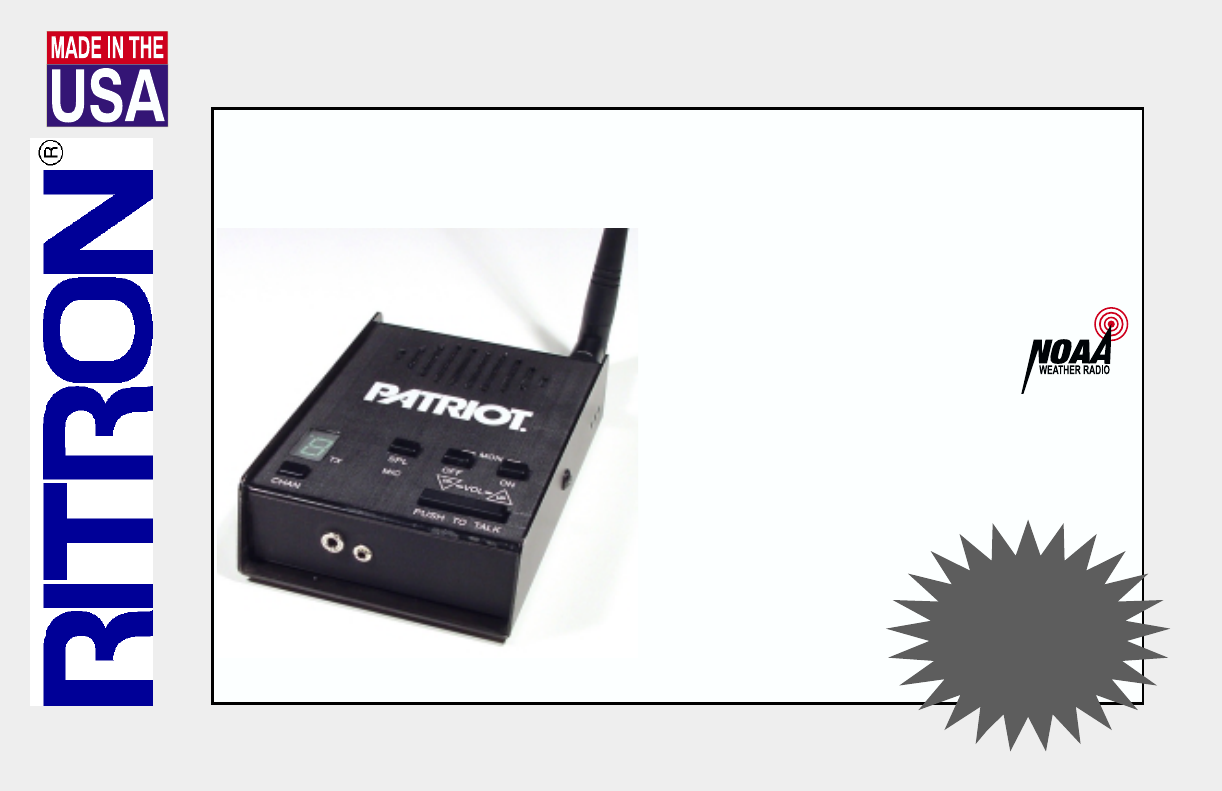
Have questions? Call
800-USA-1-USA
(800-872-1872) or visit our website at www.ritron.com
DISPLAY SERIES DESKTOP BASE RADIO
RUGGED, PRRUGGED, PR
RUGGED, PRRUGGED, PR
RUGGED, PROFESSIONAL TWOFESSIONAL TW
OFESSIONAL TWOFESSIONAL TW
OFESSIONAL TWO-O-
O-O-
O-WW
WW
WAA
AA
AY BASE RADIOSY BASE RADIOS
Y BASE RADIOSY BASE RADIOS
Y BASE RADIOS
ALAL
ALAL
ALWW
WW
WAA
AA
AYY
YY
YS THERE, ALS THERE, AL
S THERE, ALS THERE, AL
S THERE, ALWW
WW
WAA
AA
AYY
YY
YS READS READ
S READS READ
S READYY
YY
Y, AL, AL
, AL, AL
, ALWW
WW
WAA
AA
AYY
YY
YS ON!S ON!
S ON!S ON!
S ON!
•
Up to 10 channel capability
•
Vehicle 12 VDC or wall outlet 120 VAC operation
•
Weather Channel feature (VHF only)
•
Emergency Weather Alert feature
(VHF only)
•
Easy-to-hear, high audio output
•
Built-in Quiet
Call®
and Digital Quiet
Call®
Interference Eliminator
•
2-Tone Paging encode and decode
•
DTMF ANI encoding
•
Channel scan
•
2.5 Watts of power
New
CHANNEL
DISPLAY
OWNER'S MANUAL
14500036_030303.p65 4/14/03, 3:33 PM1
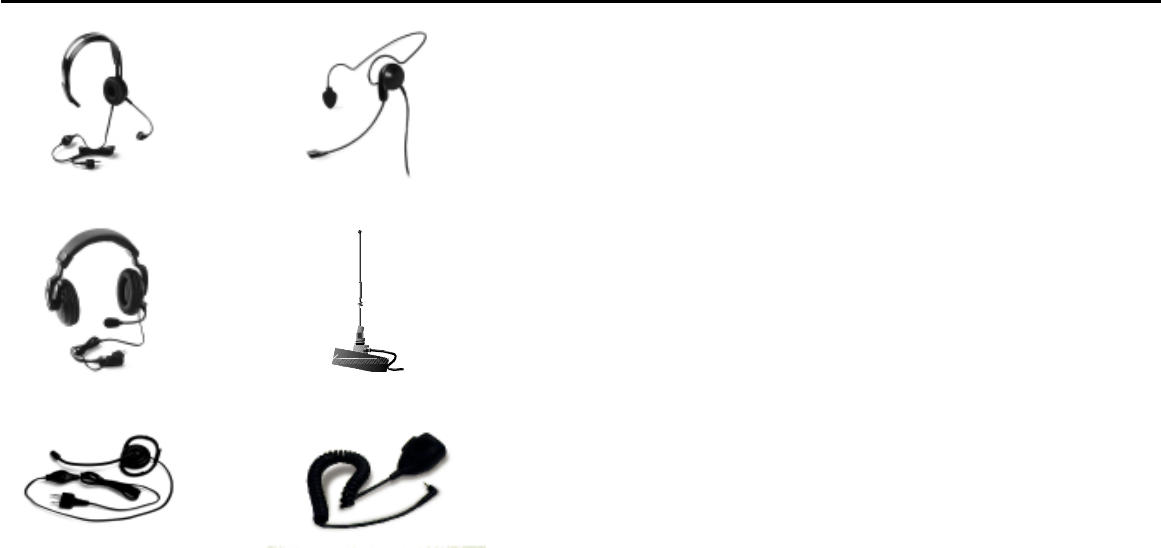
ACCESSORIES
ii
OPTIONAL / REPLACEMENT ACCESSORIES:
TO ORDER, CALL 1-800-USA-1-USA
AFB-1545 .... Molded Flex, Dual-band Replacement Antenna
RAM-1545 ... Magnet-mounted, Dual-band Antenna w/ BNC
RPS-1A ....... Replacement 110 VAC Power Supply
CCL-M ......... 12 VDC, Cigarette Lighter Adaptor
REP-2 .......... Low Profile Earphone
RHD-1X ....... Single Ear Headset
RHD-4X ....... Dual Ear Headset
RHD-5X ....... Lightweight Over-the-ear Earset /w In-line PTT
RHD-6X ....... Lightweight Behind-the-head Earset w/ In-line PTT
RSM-3X ...... Remote Speaker Microphone
RM-7 ........... Hand Microphone & Hang-up Bracket
RPS-5 ......... External Speaker w/5 Watt Audio Capability
JBS-MMK ... Mobile Mounting Kit
(Does not include screws to mount bracket to wall or vehicle)
Call RITRON for a complete listing.
RHD-1X
Single Ear Headset
RHD-4X
Dual Ear Headset
RM-7
Hand Microphone
The NEW "Display Series" model base radio contains updated programming features, and programs differently than other Ritron
Base Stations. These radios provide more channels, allow you to change channel programming contents individually, and also
allow you to delete one or more channels, and add it back in, if needed.
RHD-5X
Over-the-ear Earset
RHD-6X
Behind-the-ear Earset
Have questions? Call
800-USA-1-USA
(800-872-1872) or visit our website at www.ritron.com
RAM-1545
Magnet-mounted, Dual-band Antenna
14500036_030303.p65 4/14/03, 3:33 PM2
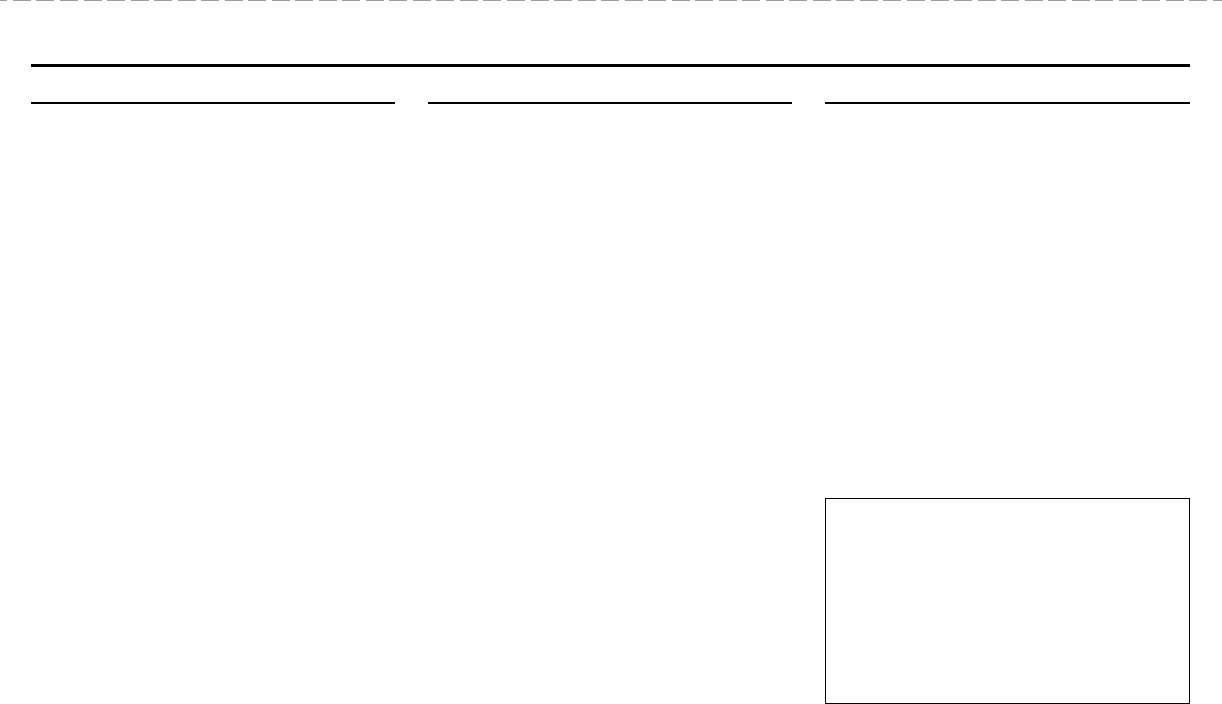
Have questions? Call
800-USA-1-USA
(800-872-1872) or visit our website at www.ritron.com
DESCRIPTION PAGE
ACCESSORIES
Optional Accessories ................................................. ii
INTRODUCTION
"Display Series" Model Numbers .............................. 1
Features ..................................................................... 1
CONTROL & OPERATION ............................................ 2
FIG-1: Radio Controls and Connectors.................... 2
OPERATION
On-off/ Volume Adjust ............................................... 3
FIG-2: Volume Level Indicator .................................. 3
Channel Selection ...................................................... 3
QC and DQC Tone Codes
(Interference Eliminator Codes) ................................ 3
Receive ...................................................................... 3
Transmit ...................................................................... 4
FIG-3: Transmit / Busy Lamp.................................... 4
Radio Alert Tones ...................................................... 4
Scan Channel Operation ........................................... 5
2-Tone Paging Operation ........................................... 5
FIG-4: 2-Tone Call Alert ............................................ 6
Special Feature "Z" Button ........................................ 6
Optional Alert Tones .................................................. 7
INSPECTION
Make sure the package includes:
• "Display Series" base radio
• Antenna
• RPS-1A Wall Mounted Power Supply
• Owner's Manual
Examine the equipment immediately after
delivery and report any damage to your
shipping company.
DESCRIPTION PAGE
NOAA WEATHER RADIO
FIG-5: Presetting Your Local NOAA Weather
Broadcasts................................................................. 7
FIG-6: NOAA Frequencies ....................................... 7
How to Preset Your Radio for Local NOAA
Weather Broadcasts ................................................. 8
NOAA Weather Channel ........................................... 8
Weather Alert ............................................................. 8
Using The "Z" Button For Weather Channel ............. 8
RADIO PROGRAMMING
FIG-7: How To Place the Radio in Program /
Readout Mode ............................................................ 9
How to Readout Field Programmed Frequency &
Tone Codes ................................................................ 9
Table 1: Programmable Frequency Codes ............ 10
Table 2: Programmable QC Tone Codes ................ 10
How to Field Program Frequency and Tone Codes 11
How to Field Program Radio Options...................... 12
Table 3: Radio Option Codes .................................. 12
PC Programmable Features ..................................... 12
How to Delete a Channel ......................................... 12
!! CAUTIONS — ALL RADIOS !!
Observe Caution in the Following Environments to
Maximize the Life of Your Radio Equipment ........... 13
Exposure to Radio Frequency Energy ................... 13
TROUBLESHOOTING .................................................. 14
DESCRIPTION PAGE
FCC LICENSE REQUIRED
FCC Regulations ...................................................... 15
Service ..................................................................... 15
How to Obtain an FCC Radio License .................... 15
LIMITED WARRANTY ................ INSIDE BACK COVER
FIGURES:
1. Radio Controls and Connectors.......................... 2
2. Volume Level indicator ........................................ 3
3. Transmit / Busy Lamp .......................................... 4
4. 2-Tone Call Alert .................................................. 6
5. Presetting Your Local NOAA Weather
Broadcasts .......................................................... 7
6. NOAA Frequencies ............................................. 7
7. How To Place the Radio in Program / Readout
Mode ..................................................................... 9
TABLE OF CONTENTS
14500036_030303.p65 4/14/03, 3:33 PM3
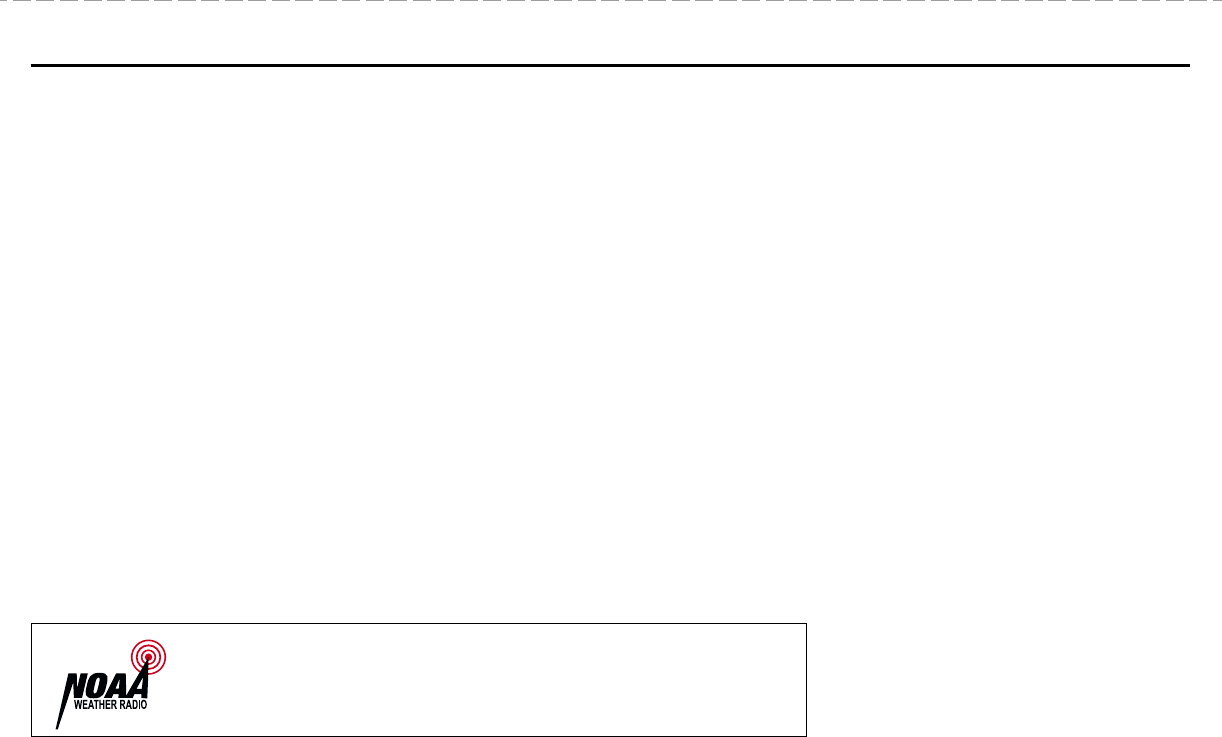
page 3 RITRON, INC. 1-800-USA-1-USA
(1-800-872-1872)
Have questions? Call
800-USA-1-USA
(800-872-1872) or visit our website at www.ritron.com
INTRODUCTION
page 1
FEATURES
This manual covers Ritron "Display Series" base radios.
These radios are rugged, programmable two-way desktop
base stations designed to operate in a professional FM
communications band (VHF or UHF business available). Each
radio is equipped with these features:
•Push-button operating controls. The Push-To-Talk
(PTT), Channel, On/ Volume Up, Volume Down/ Off and
the special feature "Z" button controls are conveniently
located on the face of the radio.
•Channel display. The LED display will show the
current operating channel, and contains a transmit/busy
lamp. The display is also used to indicate volume level
and paging decode status on radios programmed for 2-
tone paging operation.
•10-channel capability. Up to 10 channels can be
programmed to contain a unique set of operating
frequencies and options.
•QC (Quiet Call) intereference eliminator codes.
Each channel can be programmed from a list of 51 QC
sub-audible codes.
•Channel scanning. The Scan channel allows
scanning of all channels programmed into the radio, and
can be turned On and Off through Field programming.
The scan channel has many features, including Priority
Scanning and Busy Channel Blocking.
Features available through PC programming include:
•DQC (Digital Quiet Call) intereference
eliminator codes. Each channel can be
programmed from a list of 83 DQC digital privacy
codes.
•2-tone paging decode. Each channel can be
programmed for two-tone paging decode.
Additional 2-tone paging features include Group
Call, All Call, automatic reset, and transpond alert.
•DTMF ANI. Each channel can be programmed to
transmit a unique DTMF ANI string.
•Wide or narrow band operation. Each channel
is programmable for wide or narrow band transmit
operation.
•High or low transmit power. Each channel can
be programmed for high or low transmit power.
•Alert tones. Each channel is programmable for a
variety of alert tones that include RX courtesy
beep, TX clear to talk beep, busy channel lockout
alert, last active channel marker, and channel
scanning indicator.
•Squelch adjustment. Squelch sensitivity can be
programmed on a per channel basis to meet your
specific needs.
•Special feature "Z' button. The "Z" button can
be PC programmed for many unique functions such
as Scan, Weather Channel, send DTMF ANI, send
2-Tone Page, Monitor, 2-Tone reset, Priority
Channel, Talk Around, Transpond, Call Alert, or
Emergency.
See your Ritron dealer or contact Ritron directly for PC
programming of these option.
THANK YOU FOR CHOOSING RITRON
Congratulations on your purchase of the "Display
Series" base radio. Your new radio is the
culmination of Ritron's 25 years of designing,
manufacturing, and supplying reliable, profes-
sional wireless communication products. Ritron
wireless products will improve the operation,
safety, and profitability of any organization by
providing instant voice communications between
employees throughout the workplace.
"DISPLAY SERIES" MODEL NUMBERS
VHF MODELS
JBS-146D ......(Jobcom) ... (2.5-Watt, 10 Channel)
PBS-146D ...... (Patriot) ..... (2.5-Watt, 10 Channel)
UHF MODELS
JBS-446D ......(Jobcom) ... (2.5-Watt, 10 Channel)
PBS-446D ...... (Patriot) ..... (2.5-Watt, 10 Channel)
The model number located on the back of the
radio case indicates its operating band.
VHF radios are designed to operate on up to ten
channels within the 12 MHz band between
factory standard 150 and 162 MHz.
UHF radios are designed to operate on up to ten
channels within the 20 MHz band between
factory standard 450 and 470 MHz.
•Weather Channel. VHF models can be programmed to receive your local NOAA weather
radio broadcast. The Weather channel can be turned On and Off through Field programming.
•Weather Alert. VHF models can be programmed to alert you when the National Weather
Service detects threatening weather conditions. The Weather Alert feature can be turned
On and Off through Field programming.
14500036_030303.p65 4/14/03, 3:34 PM4
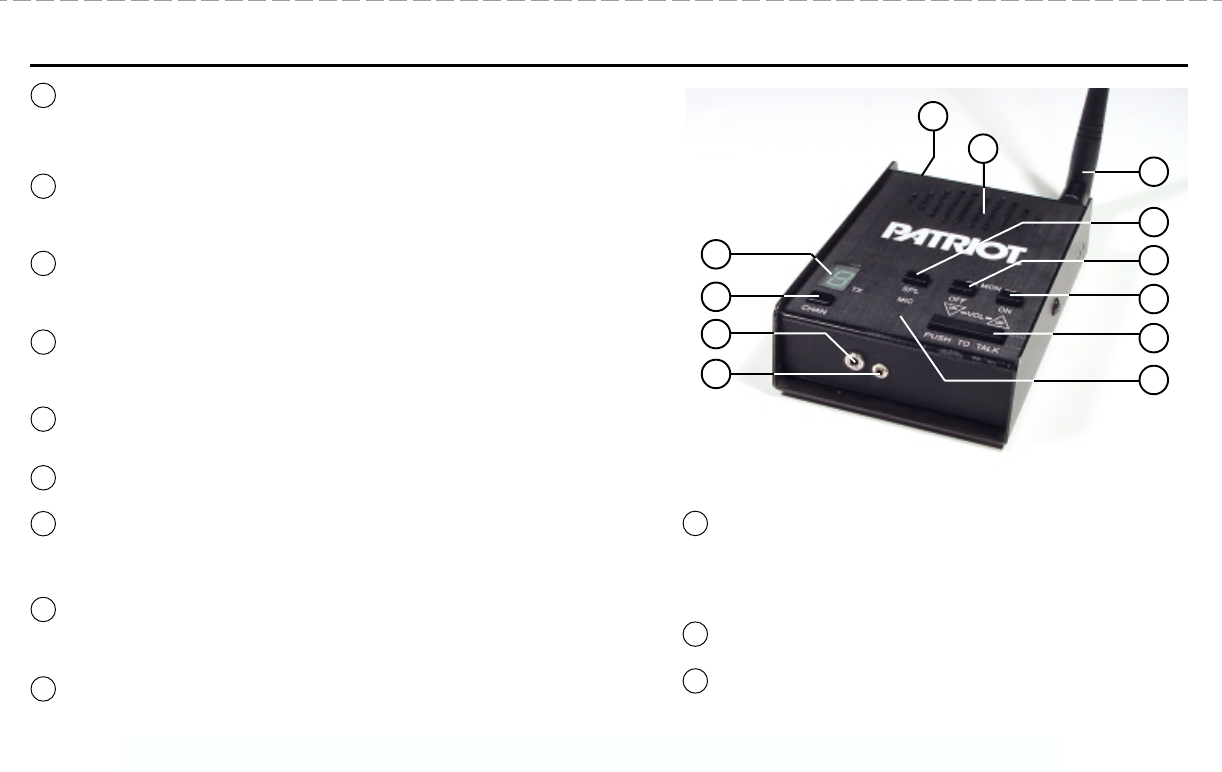
Have questions? Call
800-USA-1-USA
(800-872-1872) or visit our website at www.ritron.com
CONTROL & OPERATION
page 2
10
7
9
11
2
1
6
5
3
412
8
FIG-1: RADIO CONTROLS & CONNECTORSFIG-1: RADIO CONTROLS & CONNECTORS
FIG-1: RADIO CONTROLS & CONNECTORSFIG-1: RADIO CONTROLS & CONNECTORS
FIG-1: RADIO CONTROLS & CONNECTORS
1CHANNEL DISPLAY
The channel display will indicate the current operating channel. When the Scan Channel is
selected the display will rapidly flash the channels being scanned, and will stop when a channel
is received. The channel display also indicates the volume level between 0-9 whenever a
volume control is pressed.
2CHANNEL SELECTOR
Press the Channel Selector button and the radio will advance the channel. The Channel Beep
will be heard any time Channel 1 is selected. When the Scan Channel is selected the radio will
sound the Scan Beep and begin scanning.
3AUDIO ACCESSORY JACK
The audio accessory jack is used to plug in earphone options, and, in conjunction with the
microphone jack, to connect an optional remote speaker/ microphone or a single- or dual-ear
headset. This jack is also used for PC programming.
4MICROPHONE JACK
The microphone jack is used to connect optional external microphones and, in conjunction with
the audio accessory jack, to connect an optional remote speaker/ microphone or a single- or
dual-ear headset.
5POWER CONNECTOR (TOP END OF CASE)
The power connector on the top end of the radio is used to connect power to the unit, either an
external 12 VDC supply or the RPS-1A cube power supply included with the radio.
6SPEAKER
The speaker allows you to hear calls on your channel.
7ANTENNA
The flexible antenna radiates and receives radio signals. The antenna connects to a BNC type
connector located on the top end of the radio.
NOTE: The AFB-1545 antenna furnished with the radio will work with VHF and UHF radios.
8SPECIAL FEATURE "Z" BUTTON
The Special Feature "Z" button can be PC programmed for one of many unique functions. They
are Scan, Weather Channel, send DTMF ANI, send 2-Tone Page, Monitor, 2-Tone reset, Priority
Channel, Talk Around, Transpond, send Call Alert tone, or Emergency.
9VOLUME DOWN/ OFF
Press the Volume Down/Off button to decrease volume. The channel display will indicate the
volume level as long as the Volume Down/Off button is pressed. To switch Off the unit, press
and hold this button until the speaker sounds a double beep.
10 ON/ VOLUME UP
To switch the unit On, press the On/ Volume Up button; the speaker will sound
the Channel Beep. If the radio turns on to the Scan Channel it will sound the
Scan Beep. Once the radio is On, press this button to increase volume. The
channel display will indicate the volume level as long as the On/Volume Up
button is pressed.
11 PUSH-TO-TALK SWITCH (PTT)
Press and hold the PTT when transmitting; release it to receive.
12 MICROPHONE
The microphone allows your voice to be heard in transmissions to other radios.
Speak in a normal tone; shouting does not improve your listener's reception.
14500036_030303.p65 4/14/03, 3:34 PM5
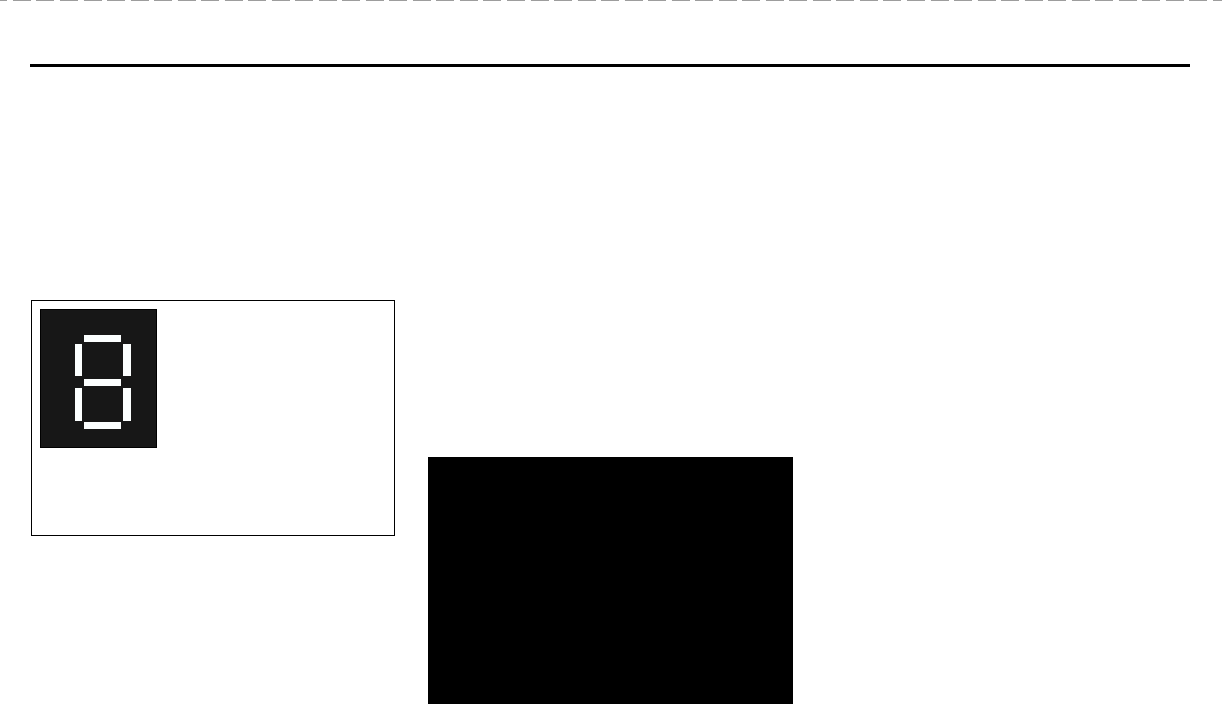
page 3 RITRON, INC. 1-800-USA-1-USA
(1-800-872-1872)
Have questions? Call
800-USA-1-USA
(800-872-1872) or visit our website at www.ritron.com
OPERATION
page 3
ON-OFF / VOLUME ADJUST
To switch on the radio - press the On/Volume Up button.
The radio will sound the Channel Beep. If the radio turns
on to the Scan Channel it will emit the Scan Beep. The
radio will turn on to the channel that was selected when
it was last turned off.
To adjust the volume - press the volume up or the volume
down button until you reach the desired level. The
display will show the volume level on a 0-9 scale as long
as the volume button is pressed, and you will hear any
broadcasts on the channel.
To turn off the radio - press and hold the Off/Volume
Down button until a two tone "turn-off" beep is heard.
For instant turn-off, press the PTT button while holding
the Off/Volume Down button.
CHANNEL SELECTION
To change channels - press and release the Channel
Selector button. The radio will increment the channel,
and the Channel Display will show the new operating
channel. If the highest channel number is selected and
you press the Channel Selector button, the radio resets
to channel 1 and the Channel Beep is heard on the
speaker.
If the Scan Channel is selected - the radio will sound the
Scan Beep and the Channel Display will rapidly flash the
channel numbers as they are scanned. If a signal is
received the channel display will indicate the channel
number, and when the received signal is removed the
radio will wait briefly, sound the Scan Beep, then
scanning will resume as normal.
If the Weather Channel is selected - on a VHF radio the
display will light a single segment of the display that
indicates which of the seven NOAA frequencies is
monitored. See the "NOAA Weather Radio" section on
page 8 for details.
RECEIVE
To hear calls from other users - adjust the volume as
desired. The radio can receive broadcasts as long as
the Push-To-Talk button is not pressed. Whether or
not you hear these broadcasts depends upon the
squelch settings.
There are four squelch modes that can be used in the
"Display Series" base radio.
•Carrier squelch lets you hear all broadcasts on
your channel strong enough for the radio to detect,
and silences noise.
•Tone squelch uses one of the QC or DQC “tone
squelch” formats available on the "Display Series"
base radio. This allows you to screen out “on-
channel” broadcasts that do not carry the correct
code programmed for the radio.
•No squelch disables all squelch operation and
noise will be heard on the speaker. This allows
you to hear even the weakest broadcasts on your
channel.
•2-tone paging can be used in conjunction with
either carrier or tone squelch to block out all calls
except those sent specifically to your radio. When
the unique 2-tone sequence programmed into the
radio is decoded, the radio will emit a series of ring
tones similar to a telephone.
Once a squelch type has been selected by the user,
all channels will operate in that mode. The "Display
Series" radio will operate in tone squelch mode when
it is 1st turned on.
To activate carrier squelch - simultaneously press
both of the volume buttons and hold briefly before
releasing. When carrier squelch is on, the radio emits
a “double beep.” The radio will now let you hear all
broadcasts on your channel.
QC AND DQC TONE CODES
(Interference Eliminator Codes)
Tone codes filter out static, noise and
reduce unwanted "chatter" on radio
channels. When you operate on a frequency
with a tone code, you screen out most
interference. This allows you to
communicate with less interference and to
hear only those users in your radio group.
IMPORTANT! All radios in the talk group
must operate on the same
frequency and tone code.
FIG-2: VOLUME LEVEL INDICATORFIG-2: VOLUME LEVEL INDICATOR
FIG-2: VOLUME LEVEL INDICATORFIG-2: VOLUME LEVEL INDICATOR
FIG-2: VOLUME LEVEL INDICATOR
As long as the Volume Up button
is held down the volume will
increase and the display will
indicate the volume level as a
number between 0 and 9.
When the Volume Down button
is held down the volume will
decrease and the display will
indicate the volume level as a
number between 9 and 0.
14500036_030303.p65 4/14/03, 3:34 PM6
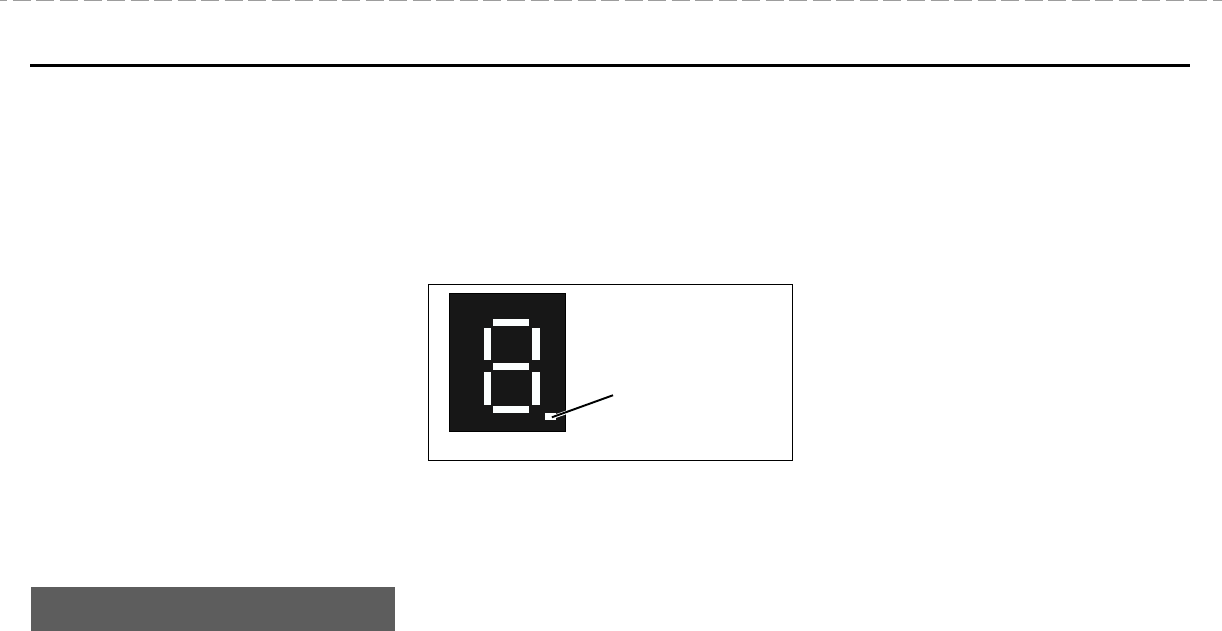
Have questions? Call
800-USA-1-USA
(800-872-1872) or visit our website at www.ritron.com
page 4
OPERATION
To activate tone squelch - simultaneously press both
volume buttons and hold briefly before releasing.
When tone squelch is turned on, the radio sounds one
beep. You will only hear broadcasts that carry the
same QC or DQC code programmed into your radio.
To activate no squelch - simultaneously press both of
the volume buttons and continue to hold them down.
About 3 seconds after the beep (or double beep), the
radio will start beeping repeatedly. This means that
squelch is turned off. Release the buttons. To restore
squelch, press and hold both of the volume buttons
until the radio sounds a beep or double beep.
If you are unable to activate carrier or no squelch the
radio has been optionally programming for Monitor
Lockout. See your Ritron dealer or contact Ritron
directly to disable this option.
To activate 2-tone paging - simultaneously press both
of the volume buttons and hold briefly before
releasing. When 2-tone paging is turned on, the radio
sounds a "triple beep". You will only hear broadcasts
that first send your two unique paging tone. If you are
unable to set the radio, you have selected a channel
that is not programmed for 2-tone paging decode.
To monitor the channel - place the radio in carrier
squelch mode.
Using the "Z" button for squelch - The "Display Series"
base radio "Z" button can be programmed to set the
squelch mode, or to simply reset 2-tone paging.
Note: The beginning of a call might be missed if the
radio is scanning or has been set for battery saver
mode. If this happens, ask the caller to repeat the
message.
TRANSMIT
Normally, you should monitor the channel before
transmitting and talk only when the channel is clear.
To transmit - hold down the Push-To-Talk button and,
with the radio at least 6 inches away, talk into the
microphone. Speak in a normal tone, since talking
louder will not improve the listener’s reception.
Keep talk times as short and infrequent as possible to
allow others to use the channel.
FIG-3: TRANSMIT/BUSY LAMPFIG-3: TRANSMIT/BUSY LAMP
FIG-3: TRANSMIT/BUSY LAMPFIG-3: TRANSMIT/BUSY LAMP
FIG-3: TRANSMIT/BUSY LAMP
A Transmit / Busy Lamp
in the lower right corner
of the Channel Display
lights whenever the
transmitter is activated
and blinks when the
channel is busy.
RADIO ALERT TONES
The radio responds to certain instructions by sounding
a beep or series of tones. These tones can tell you
that the radio is working as you expect.
Power On/Self Check “OK”
When it is first turned on, the radio runs a quick “self
test” to confirm basic functions. When complete the
radio will emit the Channel Beep and the Channel
Display will show the operating channel. The radio is
then ready to use.
Error Tones
However, if the “self test” detects a diagnostic error,
an error tone sounds. The error tone indicates the
radio frequency synthesizer is malfunctioning. Turn
off the radio and try again. The error tone will also
sound if a channel has been programmed for an
invalid frequency.
A long, low-pitched tone means the battery voltage is
too low to operate the radio. If you cannot correct the
problem, consult an authorized Ritron service facility
or Ritron.
Channel 1 Indication
When the Channel button is pressed the radio will
increment the channel, and the Channel Display will
show the new operating channel. The Channel Beep
will be heard any time channel 1 is selected.
Scan Channel
When the Scan channel is selected by pressing the
Channel button, the radio will emit the Scan Beep and
begin scanning.
Squelch Mode
When you press and hold both Volume buttons at the
same time, a single beep will sound to indicate that
tone squelch is on. A “double beep” means that
carrier squelch is on. If the channel is programmed for
2-tone paging, a "triple beep" indicate that the pager
has been reset.
Transmitter Time Out
A low tone followed by a higher-pitched tone sounds
and the transmitter automatically shuts off if you hold
down the PTT button longer than 60 seconds. The
radio automatically switches to receive mode.
Battery Alert Tone
In battery powered installations, as the battery voltage
approaches the minimum required "operating voltage"
the radio will sound a short beep every 20 seconds to
alert the user that the battery will soon need recharge
or replacement. Once the battery voltage drops below
the required "operating voltage" the radio emits a long,
low tone and turns itself off.
To use the "Z" button for Monitor see "How
To Field Program Radio Options" on page 12.
14500036_030303.p65 4/14/03, 3:34 PM7
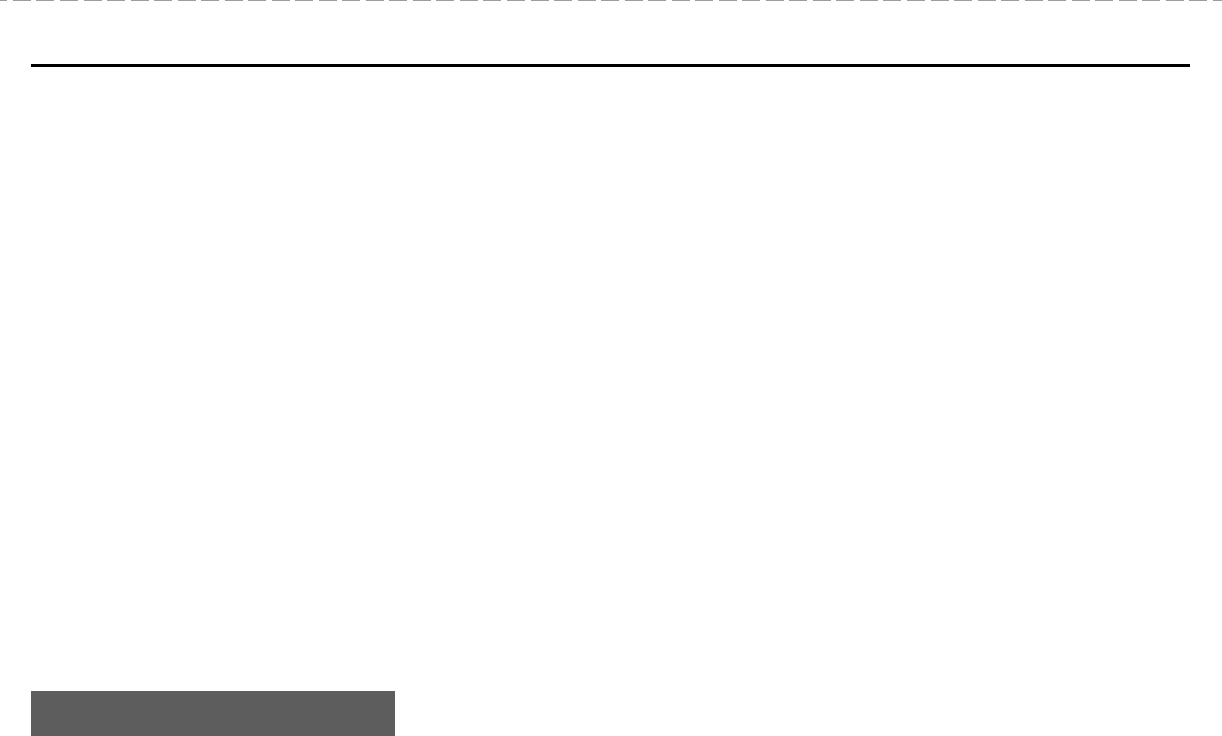
page 3 RITRON, INC. 1-800-USA-1-USA
(1-800-872-1872)
Have questions? Call
800-USA-1-USA
(800-872-1872) or visit our website at www.ritron.com
OPERATION
SCAN CHANNEL OPERATION
Channel scanning allows you to listen to broadcasts
on your radio channels. The "Display Series" base
radio will scan all channels programmed into the radio
except the NOAA Weather Channel.
How Scanning Works
Using the Channel Selector button, select the Scan
channel. The radio sounds the Scan Beep, and then
repeatedly checks each channel in the scan list. The
channel display will show the channel numbers as
they are scanned.
When receiving a call on a channel being scanned, the
radio will stop scanning to let you hear communica-
tions on that channel. After the transmission has
ended the radio will pause before it resumes scanning
to allow you time to respond.
When transmitting from the Scan channel, the radio
will go to the last channel on which a signal was
received, then transmit. After you release the PTT the
radio will pause to allow time for a response, and then
resume scanning.
Temporary Busy Channel Blocking
If one of the channels in the scan list is so busy that
you want to temporarily block it out, press the
Channel Selector button while the radio is stopped on
the channel to be blocked and hold it until scanning
resumes. The blocked channel will now be skipped in
the scan list.
The blocked channel will be returned to the scan list if
the radio is turned off and then back on again, or
when the radio channel is changed using the Channel
Selector button. The 1st channel in the scan list
cannot be blocked.
Last Channel Scanned Alert Tone
When changing channels with the Channel Selector
button, an alert tone will sound to indicate the last
channel that received a message when the radio was
scanning. This will identify the channel on which the
last message was received, and allow uninterrupted
transmission on that channel without the constraints
of scanning. You can then press the Channel
Selector button to return to the scan channel.
Using The "Z" Button For Scan
The special feature "Z" button can be programmed to
initiate scanning. PBS-446D and JBS-446D UHF base
radios are programmed for "Z" button Scan channel
operation from the factory.
To select the Scan Channel, press the "Z" button. The
radio sounds the Scan Beep, and scanning operation
is initiated. The Scan channel will not be accessible
with the Channel Selector button when the radio is
programmed for "Z" button Scan channel operation.
To return to normal channel operation, press the
Channel Selector button and the radio will return to the
channel that was selected when scanning was
initiated with the "Z" button.
To temporarily block a busy channel while scanning,
press the "Z" button while the radio is stopped on the
channel to be blocked and hold it until scanning
resumes. The blocked channel will now be skipped in
the scan list.
Priority Scanning (Optional)
The "Display Series" base radio can be optionally
programmed for priority scanning. Priority Scan
allows you to periodically monitor a Priority Channel,
even if the radio has stopped on another channel.
This will prevent missed calls on the primary operating
channel when in scan mode.
page 5
With Priority Scan enabled:
• The first channel in the scan list is the Priority
Channel.
• The radio checks the Priority Channel every two
seconds to check for activity. This time is program-
mable and can be set for 1 - 8 seconds.
• The radio can be programmed to transmit only on
the Priority Channel when scanning.
• The radio can be programmed to sound a Priority
Channel Beep whenever the radio receives on the
Priority Channel when scanning.
See your Ritron dealer or contact Ritron directly for PC
programming of this option.
2-TONE PAGING OPERATION
To use 2-tone paging the "Display Series" base
radio must be PC programmed for this option,
the radio does not operate with 2-tone decoding as it
is received from the factory. See your Ritron dealer or
contact Ritron directly for PC programming of this
option.
To activate 2-tone paging you must first select a radio
channel that has been PC programmed for 2-tone
paging decode. The radio is normally programmed to
automatically activate 2-tone decode any time the
paging channel is selected. If not, simultaneously
press both of the volume buttons and hold briefly
before releasing. The radio sounds three beeps when
2-tone paging is turned on. The "Z" button may also
be programmed for 2-tone paging reset.
If you are unable to set the radio, you have selected a
channel that is not programmed for 2-tone paging
decode.
To turn Channel Scan on / off see "How To
Field Program Radio Options" on page 12.
14500036_030303.p65 4/14/03, 3:34 PM8
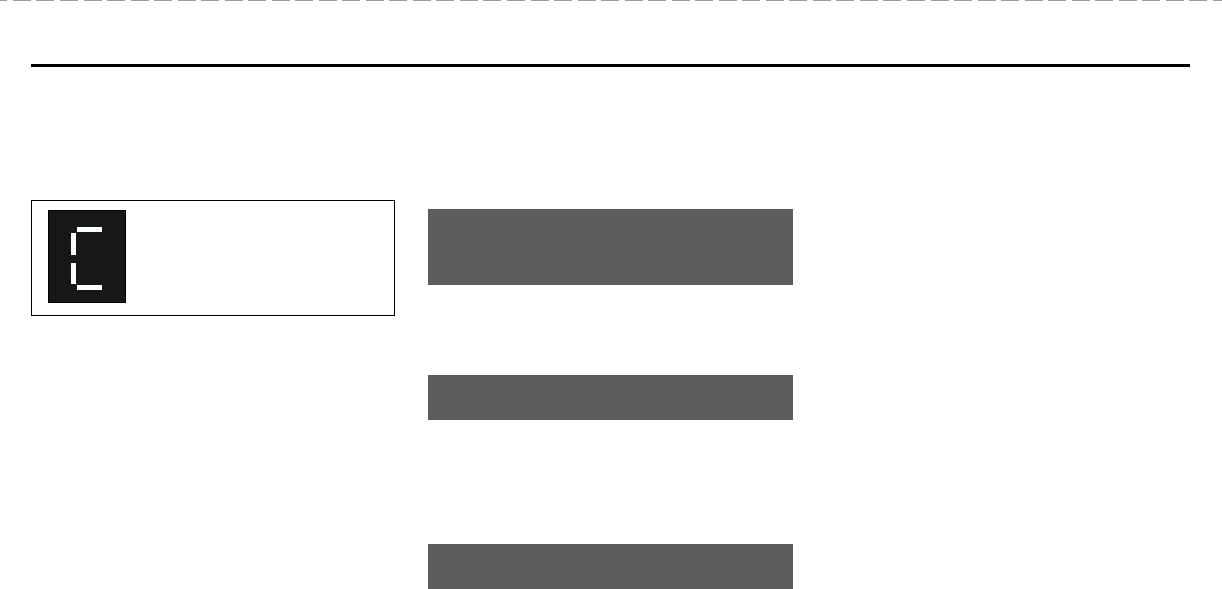
Have questions? Call
800-USA-1-USA
(800-872-1872) or visit our website at www.ritron.com
OPERATION
SPECIAL FEATURE "Z" BUTTON
The "Display Series" base radio "Z" button can be
programmed for any one of the following options to
provide unique operation. Refer to the PC programmer
HELP file for specific "Z" button programming instruc-
tions.
SCAN
PBS-446D and JBS-446D UHF base radios are
programmed for "Z" button Scan Channel operation
from the factory.
See "Using The "Z" Button For Scan" on page 5.
WEATHER
PBS-146D and JBS-146D VHF base radios are
programmed for "Z" button Weather channel operation
from the factory. This option is only available on VHF
band radios.
See "Using The "Z" Button For Weather Channel" on
page 8.
MONITOR
The "Z" button places the radio into one of the four
squelch modes when pressed.
Carrier squelch is enabled when the radio emits a
“double beep.” The radio will now let you hear all
broadcasts on your channel.
Tone squelch is enabled when the radio sounds one
beep. You will only hear broadcasts that carry the
same QC or DQC code programmed into your radio.
2-tone paging is enabled when the radio sounds a
"triple beep". You will only hear broadcasts that first
send your two unique paging tone. If you are unable
to set the radio for the "triple beep", you have selected
a channel that is not programmed for 2-tone paging
decode.
No squelch is enabled by pressing the "Z" button and
continuing to hold it down until the radio starts beeping
repeatedly. This means that squelch is turned off.
Release the button.
If you are unable to activate carrier or no squelch the
radio has been optionally programming for Monitor
Lockout. See your Ritron dealer or contact Ritron
directly to disable this option.
CALL ALERT
Pressing the "Z" button causes the radio to transmits a
Call Alert tone on the channel currently selected. If you
continue to hold the "Z" button down, the transmitter
will remain active and voice communications will be
possible after the Call Alert tone has been sent.
This is used when the receiving radio is in a high noise
environment and may not hear a voice transmission.
PRIORITY CHANNEL
Press the "Z" button to put the radio on the priority
channel programmed into the Scan list.
To return to normal channel operation, press the
Channel Selector button and the radio will return to the
channel that was selected when the Priority Channel
was accessed with the "Z" button.
page 6
When receiving a 2-tone page the radio will emit a
"ring" tone similar to a telephone and the display will
show a "C" to indicate that a call has been received.
You can now proceed with normal two way communi-
cation until 2-tone paging has been reset. The "ring"
tone will sound every time a 2-tone page is decoded.
FIG-4: 2-TONE CALL ALERTFIG-4: 2-TONE CALL ALERT
FIG-4: 2-TONE CALL ALERTFIG-4: 2-TONE CALL ALERT
FIG-4: 2-TONE CALL ALERT
The display will show a "C" to indicate
that a 2-tone call has been received.
To reset 2-tone paging after receiving a call, simulta-
neously press both of the volume buttons and hold
briefly before releasing. The radio sounds three beeps
when 2-tone paging is reset and the display will
show the channel number. The radio can be optionally
programmed to automatically reset if a call is not
answered within 15 seconds, or the "Z" button can be
programmed for 2-tone paging reset.
2-tone paging channels can be programmed to:
• Automatically set the radio for 2-tone paging mode
whenever the channel is selected.
• Automatically reset if a 2-tone page is not an-
swered within 15 seconds.
• Automatically place the receiver into carrier squelch
"monitor" mode whenever a 2-tone page has been
decoded.
• Transmit a transpond tone to let the paging station
know that the page has been received.
• Decode an All Call tone.
• Decode a Group Call if the 1st tone is sent for an
extended period of time.
See "Using The "Z" Button For Scan" on page
5.
See "Using The "Z" Button For Weather
Channel" on page 8.
To field program the "Z" button for the Scan,
Weather, Monitor, or Call Alert option see
"How To Field Program Radio Options" on
page 12.
14500036_030303.p65 4/14/03, 3:34 PM9
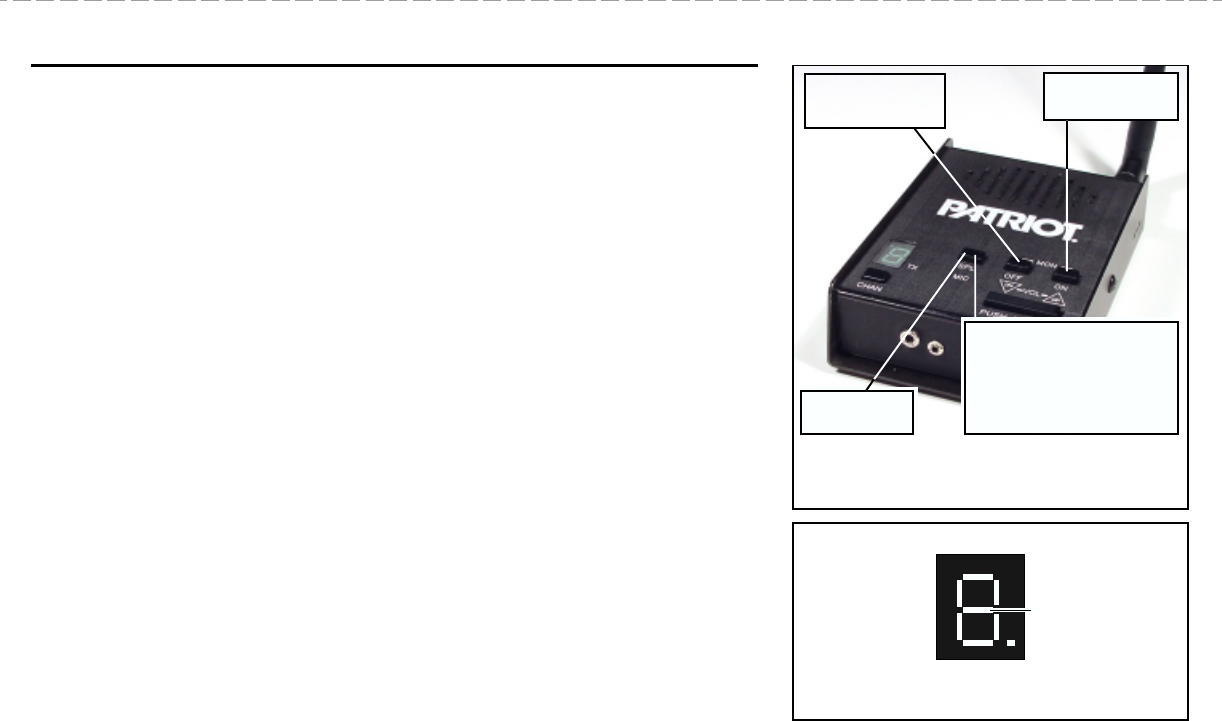
page 3 RITRON, INC. 1-800-USA-1-USA
(1-800-872-1872)
Have questions? Call
800-USA-1-USA
(800-872-1872) or visit our website at www.ritron.com
DTMF ANI
Pressing the "Z" button causes the radio to
transmits a unique DTMF ANI string that can be
programmed seperately for each channel. If you
continue to hold the "Z" button down, the transmit-
ter will remain active and voice communications will
be possible after the DTMF ANI string has been
sent.
Use the PTT button to transmit messages without
the DTMF ANI.
If a channel is not programmed with a DTMF ANI
string the "Z" button will function as a PTT button.
2-TONE PAGE
Pressing the "Z" button causes the radio to
transmits a unique 2-tone page that has been
programmed seperately for each channel. If you
continue to hold the "Z" button down, the transmit-
ter will remain active and voice communications will
be possible after the 2-tone page has been sent.
Use the PTT button to transmit messages without
the 2-tone page.
If a channel is not programmed for 2-tone paging
the "Z" button will function as a PTT button.
2-TONE RESET
Pressing the "Z" button resets the 2-tone paging
decoder on channels programmed for 2-tone paging
decode.
TALK AROUND
Pressing the "Z" button causes the radio to transmit
on the receive frequency when the channel has
been programmed for a repeater offset. If the
channel has not been programmed for a repeater
offset the "Z" button will function as a PTT switch.
OPERATION
TRANSPOND
When the "Z' button is pressed the radio transmits a
unique code that causes the receiving radio’s
transmitter to activate for a prescribed period of
time. This feature only works with other radios that
have been programmed for the RITRON transpond
feature.
EMERGENCY
When the "Z" button is pressed the radio transmits
an emergency tone, then the transmitter will remain
active for a prescribed period of time.
OPTIONAL ALERT TONES
The "Display Series" base radio can be programmed
using the RITRON PC Programmer for optional alert
tones. See your Ritron dealer or contact Ritron
directly for programming of these options.
Courtesy Beep
A short tone sounds at the end of each received
transmission to indicate that the channel is clear and
you may transmit.
Busy Channel TX Inhibit
If a user is transmitting on your radio frequency
without your tone, you will not be allowed to
transmit. The radio will beep a series of long, low
tones while the PTT is held down (like a busy
signal).
Transmit Clear To Talk Beep
A short tone sounds after the PTT has been
pressed to indicate that the radio is ready for you to
begin talking.
page 7
FIG-6: NOAA FREQUENCIESFIG-6: NOAA FREQUENCIES
FIG-6: NOAA FREQUENCIESFIG-6: NOAA FREQUENCIES
FIG-6: NOAA FREQUENCIES
162.450 MHz
162.425 MHz
162.550 MHz
162.525 MHz
162.500 MHz
162.475 MHz
162.400 MHz (center)
FIG-5: PRESETTING YOUR LOCAL NOAAFIG-5: PRESETTING YOUR LOCAL NOAA
FIG-5: PRESETTING YOUR LOCAL NOAAFIG-5: PRESETTING YOUR LOCAL NOAA
FIG-5: PRESETTING YOUR LOCAL NOAA
WEATHER BROADCASTSWEATHER BROADCASTS
WEATHER BROADCASTSWEATHER BROADCASTS
WEATHER BROADCASTS
3. PRESS & RELEASE -
THE RADIO WILL
START BEEPING.
4. CONTINUE HOLDING THE "Z"
BUTTON UNTIL THE BEEPING
STOPS, THEN RELEASE IT &
LISTEN.
5. TO FIND THE NEXT ACTIVE
WEATHER CHANNEL, PRESS &
RELEASE THE "Z" BUTTON.
1. PRESS & HOLD UNTIL
THE "RADIO OFF"
TONES ARE HEARD,
THEN RELEASE.
2. PRESS & HOLD
THE "Z"
BUTTON.
14500036_030303.p65 4/14/03, 3:34 PM10
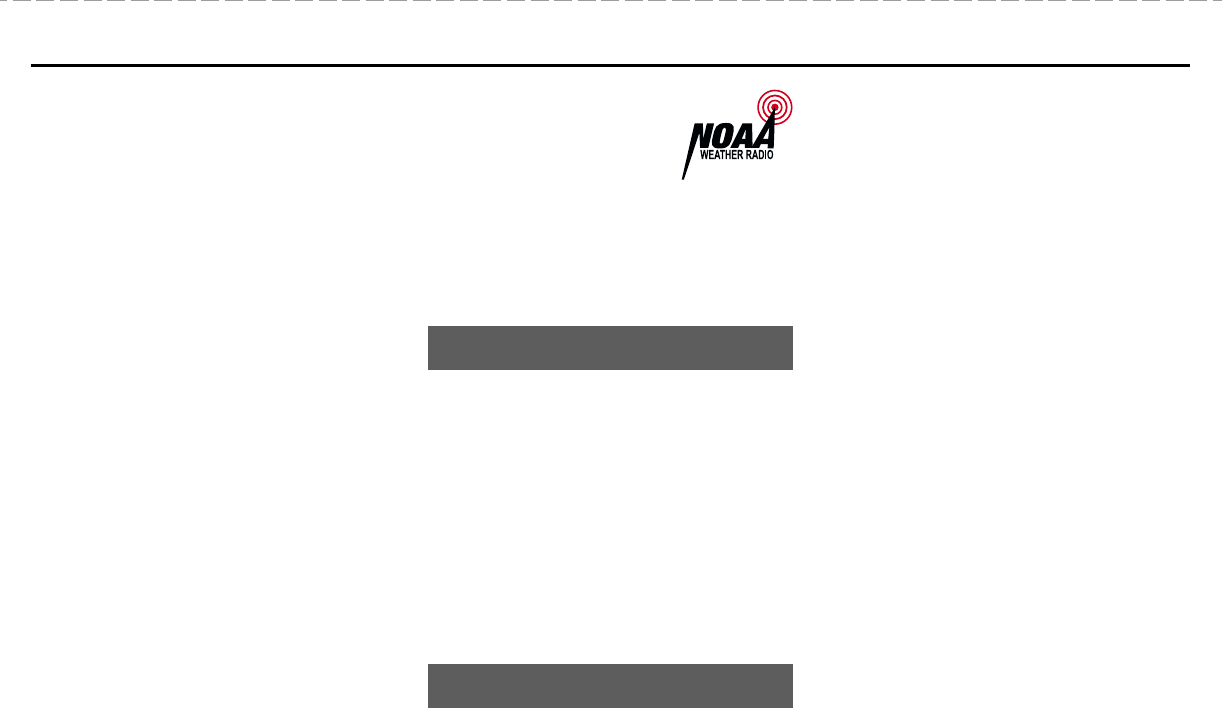
Have questions? Call
800-USA-1-USA
(800-872-1872) or visit our website at www.ritron.com
NOAA WEATHER RADIO
NOAA WEATHER CHANNEL
Once a NOAA weather frequency
has been selected on your VHF
model radio, a channel is created for
listening to National Weather
Service broadcasts.
Press the Channel button to step through your radio
channels. The NOAA Weather Channel will be after
your last channel, and the display will light the
segment representing the selected NOAA frequency.
If you do not desire a NOAA Weather Channel, it can
be turned off through Field Programming.
WEATHER ALERT
Once a NOAA weather frequency has been selected
on your VHF model radio it will listen for emergency
broadcasts from the National Weather Service,
regardless of which channel you are on.
An alert tone will sound in the speaker and the
National Weather Service emergency broadcast will
be heard, advising you of threatening weather
conditions. Pressing the Channel button will return
you to your normal operating channel.
If you do not desire Weather Alert, it can be turned off
through Field Programming.
HOW TO PRESET YOUR RADIO FOR LOCAL
NOAA WEATHER BROADCASTS
(VHF MODELS ONLY)
VHF models of the "Display Series" base radio can
hear weather forecasts from the National Weather
Service which are broadcast on one of the seven
NOAA weather frequencies. In some areas you may
be able to receive more than one broadcast.
The radio is shipped from the factory without a NOAA
frequency selected. Before using any of the NOAA
weather features on your VHF radio you must first
select the local NOAA frequency.
1. Follow the steps in FIG-5 at left to place the radio
into the Weather Frequency Select mode.
2. The radio will scan to the 1st NOAA frequency
where a broadcast is present. The display will
light a single segment to indicate the NOAA
frequency per FIG-6.
3. Monitor the channel for a few minutes to be sure it
is the broadcast for your local area.
4. Press the "Z" button to scan for the presence of
any other NOAA broadcasts, monitoring each
broadcast and noting the frequency as indicated
by the display.
5. Using the "Z" button, select the local NOAA
frequency you would like your radio to operate on.
6. Turn the radio off by pressing the Volume Down/
Off button.
7. When the radio is turned back on all weather
features will operate on the selected NOAA
frequency.
NOTE: If you move to another location within your
area, or to another state, you must "re-train"
your radio with the local NOAA frequency.
page 8
To turn Weather Alert on / off see "How To
Field Program Radio Options" on page 12.
To turn Weather Channel on / off see "How
To Field Program Radio Options" on page 12.
USING THE "Z" BUTTON FOR WEATHER
CHANNEL
PBS-146D and JBS-146D VHF base radios are
programmed for "Z" button Weather Channel operation
from the factory. This option is only available on VHF
band radios.
To select the Weather channel, press the "Z" button.
The radio will scan to the 1st NOAA frequency where
a broadcast is present. The display will light a single
segment to indicate the NOAA frequency per FIG-6 on
page 7. If the radio has been pre-set for your local
NOAA weather frequency, the radio will go directly to
that frequency when the "Z" button is 1st pressed.
With any subsequent press of the "Z" button the radio
will scan to the next active NOAA frequency.
The Weather channel will not be accessible with the
Channel Selector button when the radio is pro-
grammed for "Z" button Weather channel operation.
To return to normal channel operation, press the
Channel Selector button and the radio will return to the
channel that was selected when the Weather channel
was accessed with the "Z" button.
14500036_030303.p65 4/14/03, 3:35 PM11
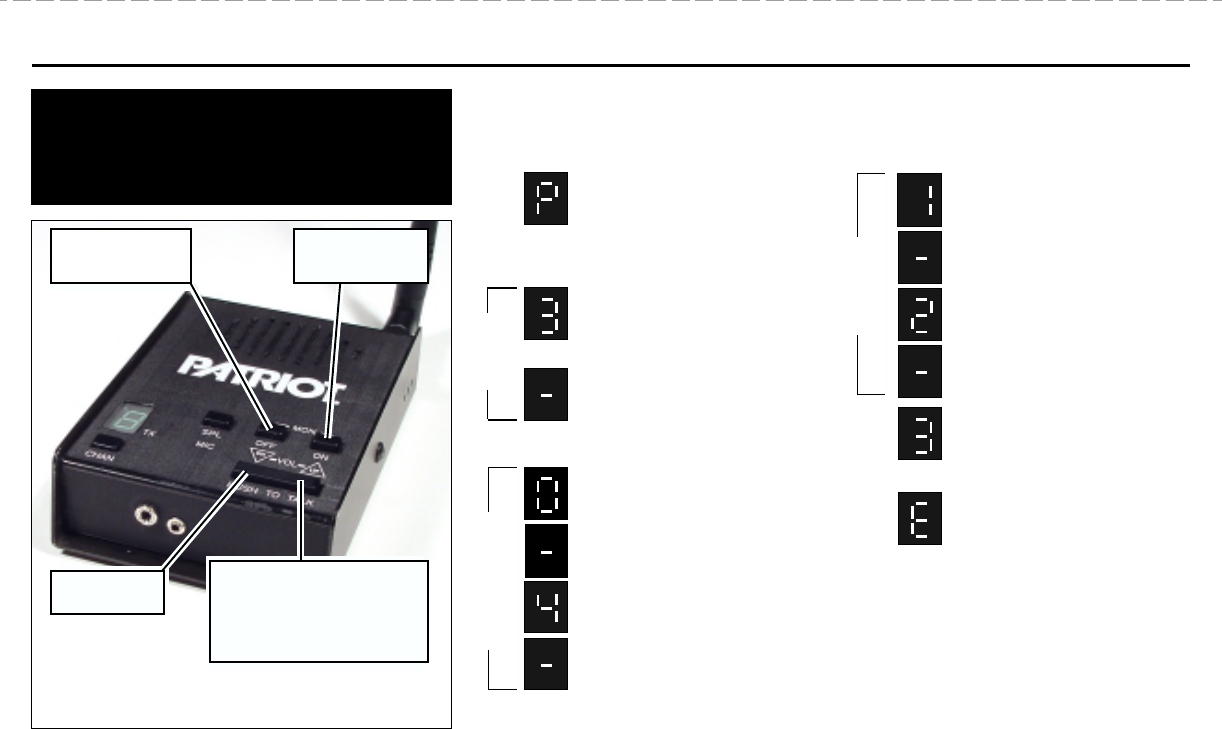
page 3 RITRON, INC. 1-800-USA-1-USA
(1-800-872-1872)
Have questions? Call
800-USA-1-USA
(800-872-1872) or visit our website at www.ritron.com
1. Place the radio into Program/
Readout Mode by following the
instructions in FIG-7 at left. A
"P" will appear on the LED
display as you enter program
mode.
2. Using the Channel button and
the LED display on the front of
the radio, select the channel
number you wish to readout.
3. When you have settled on a
channel the display will show a
hyphen across the center to
indicate that it is ready for
readout.
4. Press and release the On/
Volume Up button. The radio will
begin to display a series of four
digits; with each digit seperated
by a hyphen. The first two
digits indicate the frequency
code and the last two digits the
tone code; see Tables 1 and 2
on page 10.
RADIO PROGRAMMING
IMPORTANT
To talk to other users in your group, all
radios must be set to the same frequency
and Interference Eliminator codes.
5. The LED display will briefly
show the channel number you
have just read out and the radio
will sound a triple beep.
NOTE: If the channel is PC-
programmed for any frequency
or tone not listed in Tables 1 and
2 on page 10, an error tone will
sound and an "E" will appear
on the display.
6. To readout another channel,
repeat steps 2 through 5.
7. Turn the radio OFF and then ON
again—the radio is now ready
to use.
HOW TO READOUT FIELD PROGRAMMED FREQUENCY & TONE CODES
In our example channel 3 of a UHF radio is programmed to operate on the "Brown Dot" frequency of 464.500
MHz (Frequency code "04") with 100.0 Hz tone (Tone code "12").
FIG-7:FIG-7:
FIG-7:FIG-7:
FIG-7: HOW TO PLACE THE RADIO INHOW TO PLACE THE RADIO IN
HOW TO PLACE THE RADIO INHOW TO PLACE THE RADIO IN
HOW TO PLACE THE RADIO IN
PROGRAM/READOUT MODEPROGRAM/READOUT MODE
PROGRAM/READOUT MODEPROGRAM/READOUT MODE
PROGRAM/READOUT MODE
3. PRESS & RELEASE -
THE RADIO WILL
START BEEPING
RAPIDLY.
1. PRESS & HOLD UNTIL
THE "RADIO OFF"
TONES ARE HEARD,
THEN RELEASE.
2. PRESS & HOLD
THE PUSH-TO-
TALK BUTTON.
4. CONTINUE HOLDING THE PUSH-TO-
TALK BUTTON UNTIL THE BEEPING
STOPS, THEN RELEASE IT.
5. THE RADIO WILL EMIT A TRIPLE
TONE: IT IS NOW IN PROGRAM/
READOUT MODE.
CHANNELFREQUENCY CODE
DIGIT 1DIGIT 2
TONE CODE
DIGIT 3DIGIT 4
page 9
14500036_030303.p65 4/14/03, 3:35 PM12
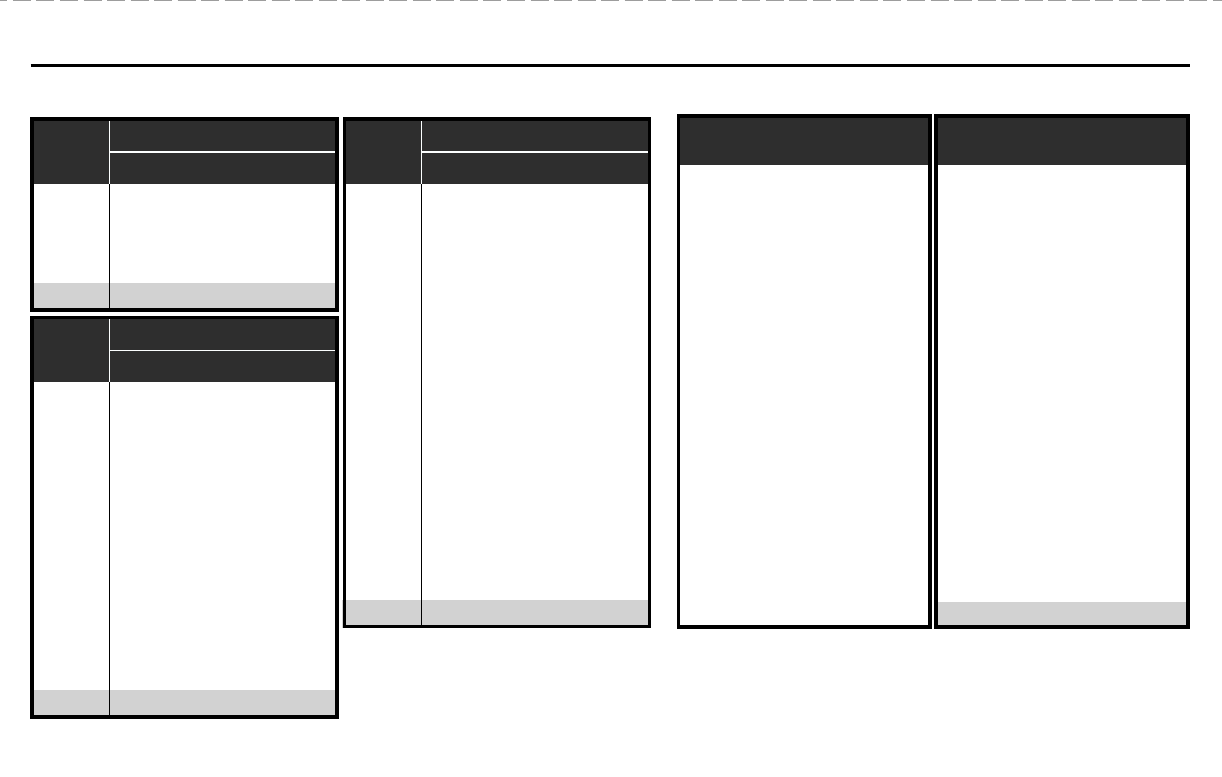
Have questions? Call
800-USA-1-USA
(800-872-1872) or visit our website at www.ritron.com
RADIO PROGRAMMING
TABLE 2: PROGRAMMABLE QC TONE CODESTABLE 1: PROGRAMMABLE FREQUENCY CODES
page 10
*2-digit Frequency placeholder code (Refer to "How to Delete a Channel" on page 12)
** MURS frequencies - The 5 MURS frequencies do not require an FCC license. All other frequencies require an
FCC license. See page 15 for license information.
NOTES: 1. Per FCC rules and regulations, a given radio must not be programmed to contain a mix of both VHF Business
Band and VHF MURS frquencies.
2. Unless otherwise noted, all frequencies listed are wideband.
Equivalent
Reed Code
6Z
6A
6B
7Z
7A
M1
--
--
--
--
--
--
--
--
--
--
--
--
--
--
--
--
--
--
--
Freq
(Hz)
167.9
173.8
179.9
186.2
192.8
203.5
210.7
218.1
225.7
233.6
241.8
250.3
69.4
159.8
165.5
171.3
177.3
No Tone
183.5
189.9
196.6
199.5
206.5
229.1
254.1
CODE #
27
28
29
30
31
32
33
34
35
36
37
38
39
40
41
42
43
44
45
46
47
48
49
50
51
00
Freq
(Hz)
67.0
71.9
74.4
77.0
79.7
82.5
85.4
88.5
91.5
94.8
97.4
100.0
103.5
107.2
110.9
114.8
118.8
123.0
127.3
131.8
136.5
141.3
146.2
151.4
156.7
162.2
Equivalent
Reed Code
XZ
XA
WA
XB
SP
YZ
YA
YB
ZZ
ZA
ZB
1Z
1A
1B
2Z
2A
2B
3Z
3A
3B
4Z
4A
4B
5Z
5A
5B
CODE #
01
02
03
04
05
06
07
08
09
10
11
12
13
14
15
16
17
18
19
20
21
22
23
24
25
26
DELETE Code
*
VHF Business Band
MHz Color Dot
CODE #
03
04
05
06
07
08
09
10
11
12
13
14
15
16
17
18
00
151.625 Red Dot
151.955 Purple Dot
151.925
154.540
154.515
154.655
151.685
151.715
151.775
151.805
151.835
151.895
154.490
151.655
151.745
151.865
DELETE Code
*
VHF MURS **
MHz Color Dot
CODE #
01
02
19
20
21
00
154.600 Green Dot
154.570 Blue Dot
151.820 narrowband only
151.880 narrowband only
151.940 narrowband only
DELETE Code
*
UHF Business Band
MHz Color Dot/Star
CODE #
01
02
03
04
05
06
07
08
09
10
11
12
13
14
15
16
17
18
19
20
21
00
467.7625 J
467.8125 K
464.5500 Yellow Dot
464.5000 Brown Dot
467.8500 Silver Star
467.8750 Gold Star
467.9000 Red Star
467.9250 Blue Star
469.2625
462.5750 White Dot
462.6250 Black Dot
462.6750 Orange Dot
464.3250
464.8250
469.5000
469.5500
463.2625
464.9125
464.6000
464.7000
462.7250
DELETE Code
*
14500036_042503.p65 4/25/03, 4:19 PM13
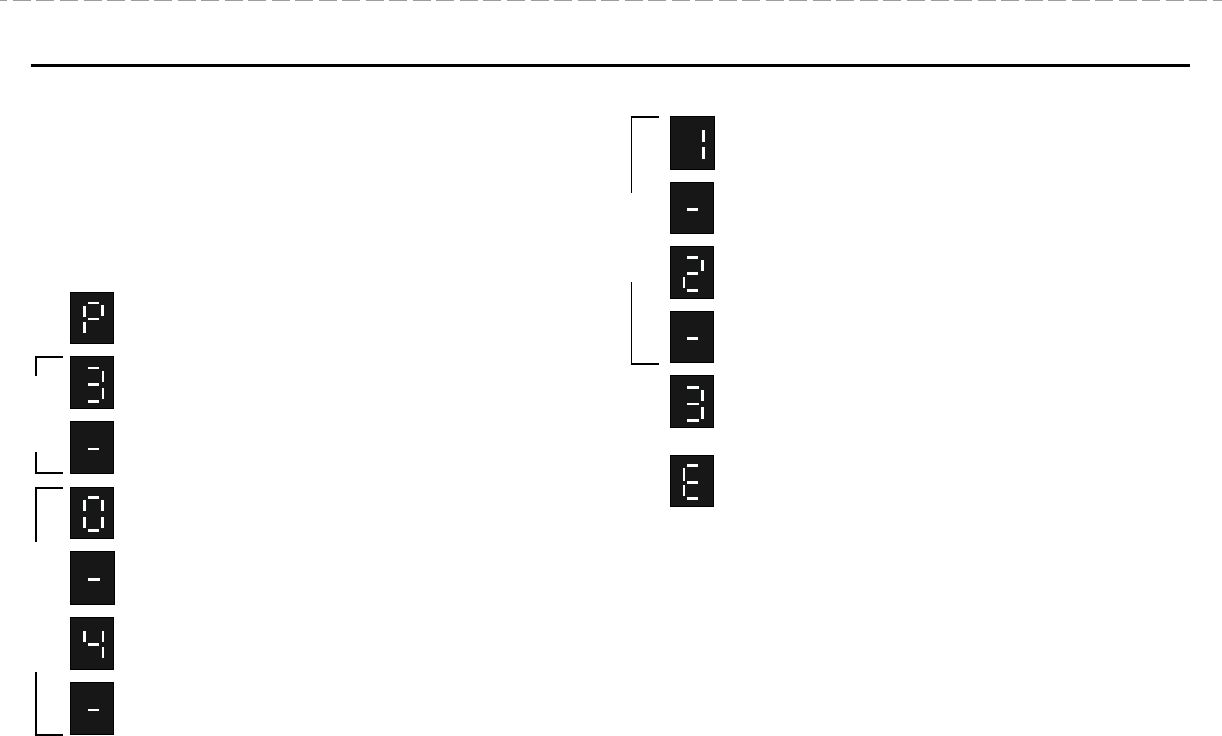
page 3 RITRON, INC. 1-800-USA-1-USA
(1-800-872-1872)
Have questions? Call
800-USA-1-USA
(800-872-1872) or visit our website at www.ritron.com
RADIO PROGRAMMING
To match other radios, the owner can select Frequency and Tone Codes from Tables 1
and 2 on page 10.
In our example we will program channel 3 of a UHF radio to operate on the "Brown Dot"
frequency of 464.500 MHz (Frequency code "04") with 100.0 Hz tone (Tone code "12").
1. Refer to Table 1 on page 10 to determine the two digit frequency
code and write it down.
2. Refer to Table 2 on page 10 to determine the two digit tone code
for 100.0 Hz and write it down.
3. Place the radio into Program/ Readout Mode by following the
instructions in FIG-7 on page 9. A "P" will appear on the LED
display as you enter program mode.
4. Using the Channel button and the LED display on the front of the
radio, select the channel number you wish to program.
5. When you have settled on a channel the display will show a
hyphen across the center to indicate that it is ready for
programming.
6. Using the PTT (push-to-talk) button and the LED display, select the
1st digit of the 2-digit frequency code you wish to program into the
radio.
7. Pause—the display will change and show a hyphen, you will also
hear a short low tone.
8. Using the PTT (push-to-talk) button and the LED display, select the
2nd digit of the 2-digit frequency code you wish to program into the
radio.
9. Pause—the display will change and show a hyphen, you will also
hear a short low tone.
10. Using the PTT (push-to-talk) button and the LED display, select the
1st digit of the 2-digit tone code (or No Tone code "44") you wish to
program into the radio.
11. Pause—the display will change and show a hyphen, you will also
hear a short low tone.
12. Using the PTT (push-to-talk) button and the LED display, select the
2nd digit of the 2-digit tone code (or No Tone code "44") you wish to
program into the radio.
13. Pause—the display will change and show a hyphen, you will also
hear a short low tone.
14. Press and release the On/ Volume Up to SAVE your programming
entry. The LED display will briefly show the channel number you
have just programmed and the radio will sound a triple beep to
indicate that programming was successful.
NOTE: An error tone will sound if you attempt to save an incorrect
code and an "E" will appear on the display. Turn the radio OFF,
check the digits you are attempting to enter, then start over.
15. To program another channel, repeat steps 4 through 14.
16. Turn the radio OFF and then ON again—the radio is now ready to
use.
NOTES:
a. YOU MUST enter "44" to enter "No Code" interference eliminator to match radios not
having tone codes. Refer to Table 2 on page 10.
b. If the radio does not sound a confirming triple tone when you attempt to enter
Program/ Readout Mode, the radio was factory or dealer customized to disable
programming. Consult the radio owner or your dealer.
HOW TO FIELD PROGRAM FREQUENCY & TONE CODES
FREQUENCY CODE CHANNEL
04
12
EXAMPLE
CODES
TONE CODE
page 11
14500036_030303.p65 4/14/03, 3:35 PM14
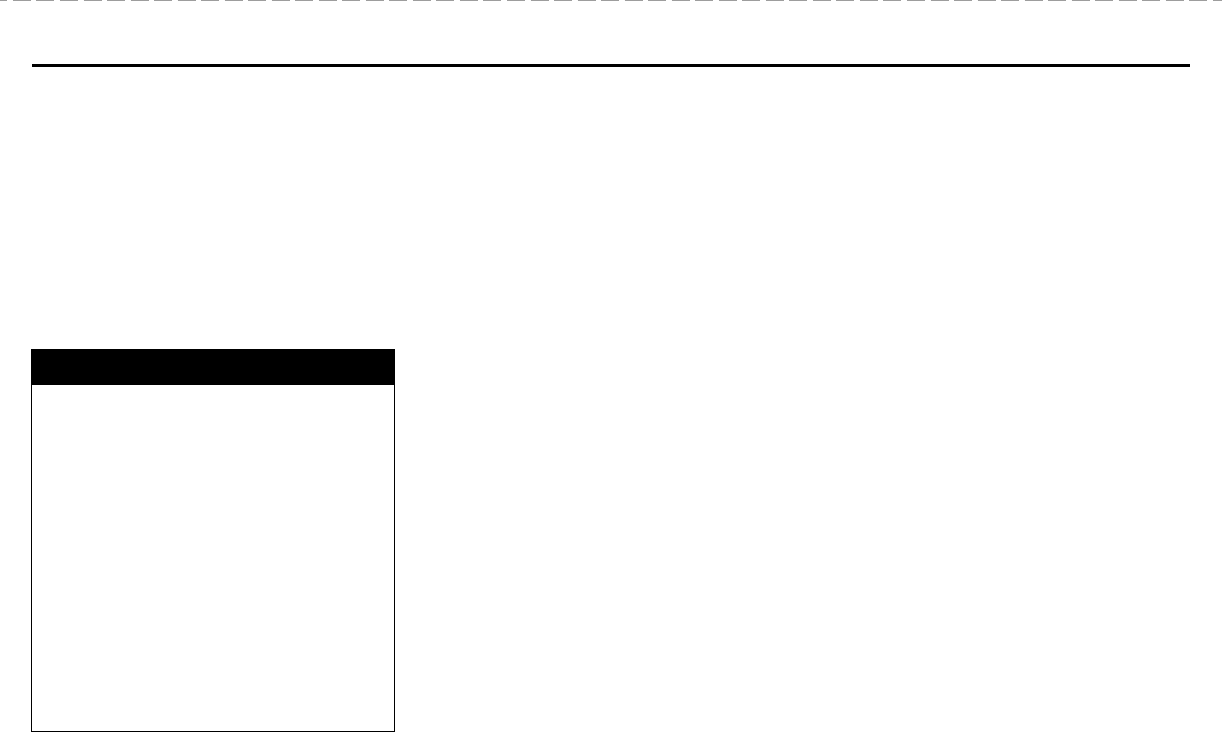
Have questions? Call
800-USA-1-USA
(800-872-1872) or visit our website at www.ritron.com
RADIO PROGRAMMING
PC PROGRAMMABLE FEATURES
The "Display Series" base radio has many features
available through PC programming. See your Ritron
dealer or contact Ritron directly for PC programming of
these option.
Receive and Transmit Frequency on any channel
can be programmed to any valid frequency within it's
designated band. (See "Display Series Model
Numbers" for frequency bands)
QC or DQC Selective Signaling on any channel can
decode and encode any of 51 available QC privacy
codes or 83 available DQC digital privacy codes.
Squelch Tightener on any channel can adjust
carrier squelch UP to block distant signals or DOWN to
hear more distant signals.
Wide or Narrow Band Transmit on any channel.
Transmit Power can be set on any channel to high
or low power.
Monitor Lock Out can be set on any channel to
prevent monitoring of the channel, only broadcasts
with the correct QC or DQC code can be heard.
Transmit Inhibit on Busy Channel can be set on
any channel to prevent transmitting when a broadcast
is present on the receiver that does not carry the
correct code. This feature is usually used in
conjunction with Monitor Lock Out.
Courtesy Beep sounds a short tone at the end of
each received transmission to indicate that the
channel is clear and you may transmit.
Transmit Clear To Talk Beep Any channel can be
set to sound a short tone after the PTT has been
pressed to indicate that the radio is ready for you to
begin talking.
Transmit Time Out time can be changed.
Power Saver "sleep" time can be set, or power
saver can be disabled.
Disable Field Programming to allow PC
programming only.
Scan Channel can be programmed or edited to
include any of the radio channels, even channels that
are not selected with the Channel Selector button.
Other programmable scan features include scan
resume delay time, busy channel blocking, last active
channel beeps, and priority scanning options.
2-Tone Paging Decode can be set on any channel.
Programmable options include the setting of the 2 tone
frequencies and duration, all call, group call, call
transpond, automatic setting of 2-tone decode when
the channel is selected, automatic reset of the 2-tone
decode if a call is not answered within 15 seconds,
and automatically set the radio to carrier squelch mode
after a 2-tone page is received.
HOW TO DELETE A CHANNEL
Following the instructions in "How to Field Program
Frequency & Tone Codes" on page 11, enter a
Frequency Code of "00" and a Tone Code of "00". Once
a channel has been deleted it is no longer available with
the Channel Selector.
A deleted channel can be added back at any time. To
add a deleted channel back, follow the instructions in
"How to Field Program Frequency & Tone Codes" on
page 11.
page 12
HOW TO FIELD PROGRAM RADIO OPTIONS
1. Follow the instructions in FIG-7 on page 9 to place
the radio in the Program/ Readout Mode.
2. Using the PTT (push-to-talk) button and the LED
display, enter the single digit code from Table 3
below for the option to be programmed.
3. Pause—the display will change and show a hyphen,
you will also hear a short low tone.
4. Press and release the On/ Volume Up to SAVE your
programming entry. The radio will sound a triple beep
to indicate that programming was successful.
5. Turn the radio OFF and then ON again—the radio is
now ready to use.
TABLE 3: RADIO OPTION CODES
CODE OPTION
1 Turn channel scan on
2 Turn channel scan off
3 Turn weather channel on
4 Turn weather channel off
5 Turn weather alert on
6 Turn weather alert off
7 Assign SCAN option to Z Button
8 Assign WEATHER option to Z Button
9 Assign MONITOR option to Z Button
0 Assign CALL ALERT option to Z Button
NOTES:
1. Codes 1 & 2 have no effect if Option 7 is selected
2. Codes 3 & 4 have no effect if Option 8 is selected
3. Code 0 is entered by pressing the PTT 10 times
14500036_030303.p65 4/14/03, 3:35 PM15
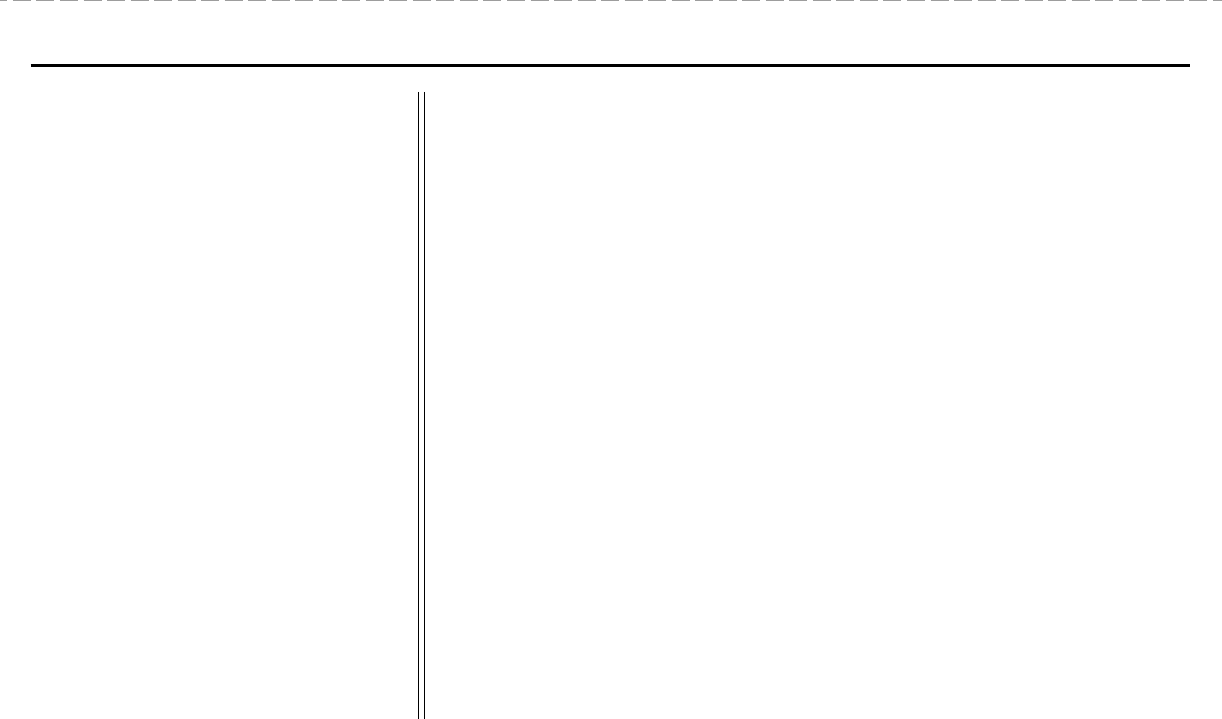
page 3 RITRON, INC. 1-800-USA-1-USA
(1-800-872-1872)
Have questions? Call
800-USA-1-USA
(800-872-1872) or visit our website at www.ritron.com
!! CAUTIONS— ALL RADIOS !!
OBSERVE CAUTION IN THE FOLLOWING
ENVIRONMENTS TO MAXIMIZE THE LIFE OF
YOUR RADIO EQUIPMENT:
LOCATION: Be aware that this radio and/or antenna
may create interference with, or be interfered with,
by nearby electronic equipment such as computers,
monitors, keyboards, electronic telephones and
other sensitive devices. Either move the equipment
or use a remote antenna to separate components
sufficiently to stop or reduce interference.
MOISTURE: "Display Series" base radios are not
waterproof. DO NOT directly expose them to rain or
excessive moisture.
CHEMICALS: Detergents, alcohol, aerosol sprays or
petroleum products can damage the radio case. DO
NOT use petroleum solvents of any kind; use a soft
cloth moistened with water to clean the case.
EXTREME HEAT: High temperatures can damage the
radio and its components. DO NOT expose the units
to extreme heat or leave them in direct sunlight.
EXCESSIVE TRANSMISSIONS: DO NOT hold the
Push-To-Talk switch down longer than necessary
during transmission intervals.
VIBRATION/ SHOCK: Although your "Display Series"
base radio is designed to be rugged, it will not
survive excessive abuse. Avoid dropping the radio.
JBS-/PBS-146D: This product generates radio frequency (RF) energy when the PTT button on the front of the
unit is depressed. This product has been evaluated for compliance with the maximum permissible exposure
limits for RF energy at the maximum power rating of the unit when using antennas available from RITRON. To
comply with the General Population/Uncontrolled limits, al persons must be at least 7.9 inches (20 cm) from the
AFB-1545 antenna which is supplied by RITRON to be attached directly to the rear of the unit. For the RITRON
RAM-1545 magnet mount antenna which can be located away from the unit, all persons must remain at least
10.8 inches (28 cm) from the antenna. Antennas other than the two mentioned above have not been tested for
compliance and may or may not meet the exposure limits at the distances given. Higher gain antennas are
capable of generating higher fields in the strongest part of their field and would, therefore, require a greater
separation from the antenna.
JBS-/PBS-446D: This product generates radio frequency (RF) energy when the PTT button on the front of the
unit is depressed. This product has been evaluated for compliance with the maximum permissible exposure
limits for RF energy at the maximum power rating of the unit when using antennas available from RITRON. To
comply with the Occupational/Ccontrolled limits, al persons must be at least 7.9 inches (20 cm) from the antenna
when transmitting. Antennas other than those available from RITRON have not been tested for compliance and
may or may not meet the exposure limits at the distances given. Higher gain antennas are capable of generating
higher fields in the strongest part of their field and would, therefore, require a greater separation from the
antenna. This product is not to be used by the general public in an uncontrolled environment unless compliance
with the Uncontrolled/General Population limits for RF exposure can be assured.
To limit exposure to RF energy to levels below the limit, please observe the following::
• Use only the antenna(s) available from RITRON for these models. DO NOT operate the radio without an
antenna.
• Keep talk times as short and infrequent as possible. DO NOT depress the PTT button when not actually
wishing to transmit. These radios are equipped with an internal timer to limit continuous transmit times.
• When transmitting, make certain that the distance limits for the particular model in use are observed.
•DO NOT allow children to operate the radio.
EXPOSURE TO RADIO FREQUENCY ENERGY
page 13
14500036_042503.p65 4/25/03, 11:06 AM16
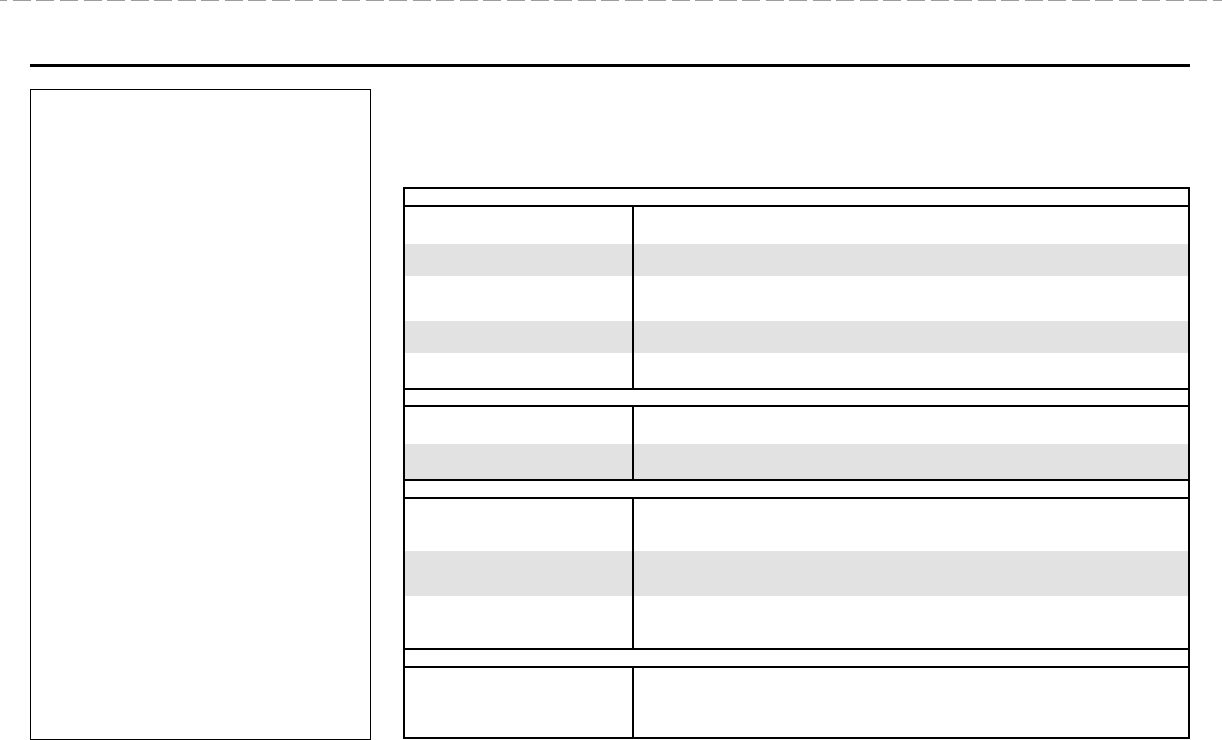
Have questions? Call
800-USA-1-USA
(800-872-1872) or visit our website at www.ritron.com
TROUBLESHOOTING
1. • Reception can often be improved if you
relocate by a short distance. This effect is
more noticeable inside buildings.
• The range of the "Display Series" base
radio is approximately two miles, line-of-
sight.
2. If your radio does not detect calls from other
radios on the channel, turn off Quiet Call by
pressing and holding both volume buttons at the
same time—a double beep indicates Quiet Call is
off.
3. • Without use of a repeater: To hear a call, select a
channel programmed to receive the caller's
transmit frequency. To call another unit, select a
channel programmed to transmit the other radio's
receive frequency.
• Using a repeater: A radio channel can hold two
separate operating frequencies, one for receive
and one for transmit. Your channel must work
with the repeater's transmit and receive
frequencies.
• NOTE: A dealer must program the radio for
repeater operation.
4. • An optional RM-7 Remote Speaker/
Microphone and headset, plus the CCL-M
12 VDC Adapter, allow operation in a
vehicle. See page ii for accessories.
5. • To "talk" with each other, radios must be
programmed identically for Quiet Call code, as
well as frequency. Each code is unique; radios
respond only to the code programmed.
• Press and hold both volume buttons at the same
time.
A single beep indicates Quiet Call squelch is on.
A double beep indicates Quiet Call squelch is off.
CHART
NOTES
If you have trouble operating the base radio, review the Control & Operation, pages 2 through 7.
If you think the base radio is malfunctioning, check the list below.
Problem Possible Solutions
GENERAL
The radio does not work at all. • Make sure the 120 VAC outlet is active and the RPS-1A power supply is
connected.
Operating features do not work • The radio has been dealer programmed for customized operation.
exactly as expected. (Consult dealer.)
Reception is poor. • Move to a different location. (See Note 1.)
• Confirm the proper antenna is connected to the radio.
• Use an optional high-gain antenna. See page ii, Optional Accessories.
You cannot hear calls from • Turn off Quiet Call (coded) squelch. (See Note 2.)
other radios. • Ensure radio receives the same frequency the caller transmits. (See Note 3.)
Your calls cannot be heard in • Make sure that your radio transmits on the receive frequency of the radio(s) you
other radios. want to call. (See Note 3.)
ERROR TONES
An error tone sounds when the • See "Error Tones" on page 4.
radio is first switched on.
An error tone occurs while • Refer to "Transmitter Time-Out," page 4.
transmitting.
QUIET CALL
You cannot screen out calls • Make sure that the channel is programmed with Quiet Call.
from users outside of your Quiet • Activate coded squelch. (See Note 5.)
Call group.
You cannot hear Quiet Call • Confirm that the channel is programmed to detect the same code as the calling
messages while in Quiet Call radio(s) transmits. (See Note 5.)
(coded) squelch.
Others in your Quiet Call group • Verify that you transmit the same code as the radio(s) you call are
cannot hear your Quiet Call programmed to detect. (See Note 5.)
messages.
SCAN
The radio constantly stops on • Skip over the interfering channel when scanning.
a busy channel, preventing you See "Temporary Busy Channel Blocking" on page 5.
from hearing calls on other
channels.
page 14
14500036_030303.p65 4/14/03, 3:35 PM17
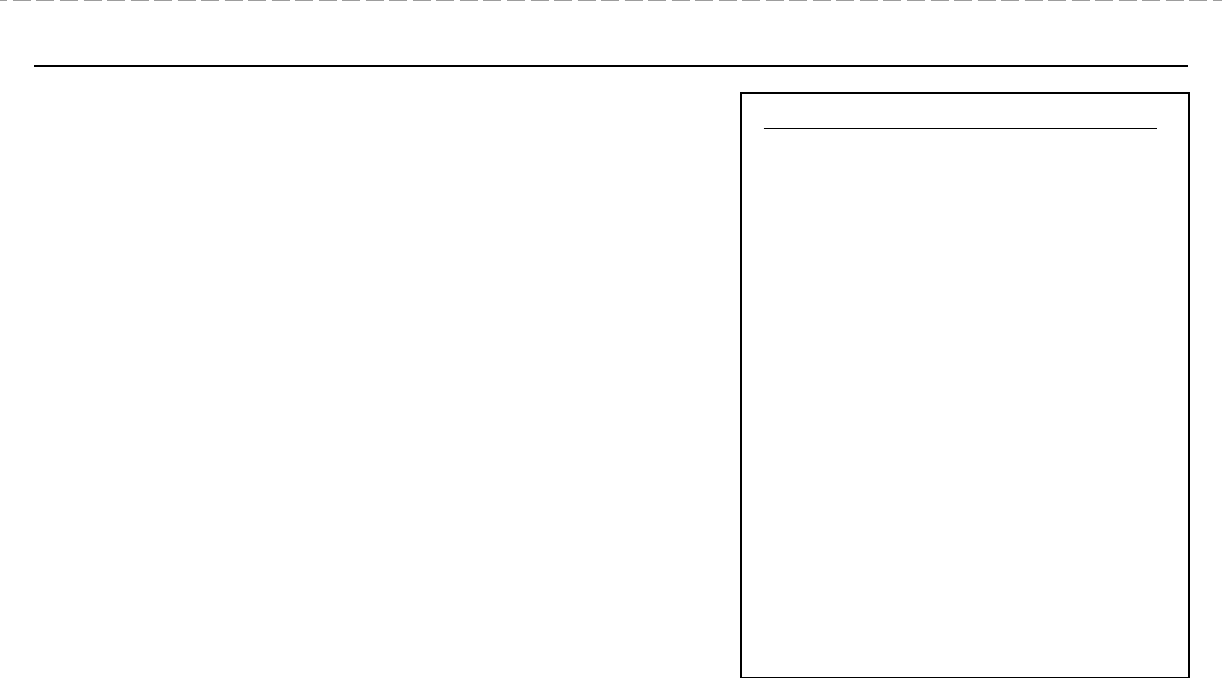
page 3 RITRON, INC. 1-800-USA-1-USA
(1-800-872-1872)
Have questions? Call
800-USA-1-USA
(800-872-1872) or visit our website at www.ritron.com
FCC REGULATIONS
LICENSING —
The FCC requires the owners of the radios to obtain a station license before using them.
The station licensee is responsible for ensuring that transmitter power, frequency and deviation are within
the limits specified by the station license. The station licensee is also responsible for proper operation and
maintenance of the radio equipment. This includes checking the transmitter frequency and deviation
periodically, using appropriate methods.
To get a FCC license for VHF or UHF frequencies, submit FCC application Form 600 as indicated in the
block at right. Your Ritron dealer can help you with this process.
SAFETY STANDARDS —
The FCC (with its action in General Docket 79-144, March 13, 1985) has adopted a safety standard for
human exposure to radio frequency electromagnetic energy emitted by FCC regulated equipment. Ritron
observes these guidelines and recommends that you do also:
• DO NOT hold the radio so that the antenna is very close to or touching exposed parts of the body,
especially the face or eyes, while transmitting. Keep the radio vertical, four inches away while
talking into the front panel.
• DO NOT press the Push-To-Talk except when you intend to transmit.
• DO NOT operate radio equipment near electrical blasting caps or in an explosive atmosphere.
• DO NOT allow children to play with any radio equipment that contains a transmitting device.
• Repair of Ritron products should be performed only by Ritron authorized personnel.
SERVICE
Federal law prohibits you from making any internal adjustments to the transmitter, and/ or from changing
transmit frequencies unless you are specifically designated by the licensee.
If your radio equipment fails to operate properly, or you wish to have the radio programmed, contact your
authorized dealer or Ritron.
RITRON, INC., Repair Department
505 West Carmel Drive
Carmel, IN 46032 USA
Phone: 317-846-1201
FAX: 317-846-4978
FCC LICENSE REQUIRED
HOW TO OBTAIN AN FCC RADIO LICENSE
Federal Communications Commission
(FCC) Licensing Information
Because your Ritron radio operates on Private Land
Mobile frequencies, it is subject to the Rules and
Regulations of the FCC, which requires all operators
of these frequencies to obtain a station license before
operating their equipment. Make application for your
FCC license on FCC Forms 600 and 159.
To have forms and instructions faxed to you by
the FCC, call the FCC Fax-On-Demand system at
202-418-0177 from your fax machine;
request Document 000600 & Form 159.
To have Document 000600 & Form 159 mailed to you,
call the FCC Forms Hotline at
800-418-FORM (800-418-3676).
For help with questions concerning the
license application, contact the FCC at
888-CALL-FCC (888-225-5322).
You must decide which radio frequency(ies) you
can operate on before filling out your application.
For help determining your frequencies, call Ritron at
800-USA-1-USA (800-872-1872).
page 15
14500036_030303.p65 4/14/03, 3:35 PM18

Have questions? Call
800-USA-1-USA
(800-872-1872) or visit our website at www.ritron.com
WHAT THIS WARRANTY COVERS
RITRON, INC. ("RITRON") provides the following warranty against defects in materials and/or
workmanship in RITRON Radios and Accessories under normal use and service during the applicable
warranty period (as stated below). "Accessories" means antennas, holsters, chargers, earphones, speaker/
microphones and items contained in the programming and programming/service kits.
WHAT IS COVERED FOR HOW LONG WHAT RITRON WILL DO
"Display Series" Base 1 year
*
During the first year after date of purchase,Series
Radios RITRON will repair or replace the defective
product, at RITRON's option, parts and
labor included at no charge.
Accessories 90 days
**
After date of purchase
WHAT THIS WARRANTY DOES NOT COVER:
•
Any technical information provided with the covered product or any other RITRON products;
•
Installation, maintenance or service of the product, unless this is covered by a separate written
agreement with RITRON;
•
Any products not furnished by RITRON which are attached or used with the covered product, or
defects or damage from the use of the covered product with equipment that is not covered (such as
defects or damage from the charging or use of batteries other than with covered product);
•
Defects or damage, including broken antennas, resulting from:
- misuse, abuse, improper maintenance, alteration, modification, neglect, accident or act of God,
- the use of covered products other than in normal and customary manner or,
- improper testing or installation;
•
Defects or damages from unauthorized disassembly, repair or modification, or where unauthorized
disassembly, repair or modification prevents inspection and testing necessary to validate warranty
claims;
•
Defects or damages in which the serial number has been removed, altered or defaced.
•
Batteries if any of the seals are not intact.
WHO IS COVERED BY THIS WARRANTY
This warranty is given only to the purchaser or lessee of covered products when acquired for use, not resale.
This warranty is not assignable or transferable.
IMPORTANT
This warranty sets forth the full extent of RITRON’s express responsibilities regarding the covered products,
and is given in lieu of all other express warranties. What RITRON has agreed to do at left is your sole and
exclusive remedy. No person is authorized to make any other warranty to you on behalf of RITRON.
Warranties implied by state law, such as implied warranties of merchantability and fitness for a particular
purpose, are limited to the duration of this limited warranty as it applies to the covered product. Incidental
and consequential damages are not recoverable under this warranty (this includes loss of use or time,
inconvenience, business interruption, commercial loss, lost profits or savings). Some states do not allow
the exclusion or limitation of incidental or consequential damages, or limitation on how long an
implied warranty lasts, so the above limitations or exclusions may not apply to you. Because each
covered product system is unique, RITRON disclaims liability for range, coverage, or operation of
the system as a whole under this warranty.
HOW TO GET WARRANTY SERVICE
To receive warranty service, you MUST deliver or send the defective product, delivery costs and insurance
prepaid, within the applicable warranty period, to RITRON, INC., 505 West Carmel Drive, Carmel, Indiana
46032, Attention: Warranty Department.
Please point out the nature of the defect in as much detail as you can. You MUST retain your sales or lease
receipt (or other written evidence of the date of purchase) and deliver it along with the product. If
RITRON chooses to repair or replace a defective product, RITRON may replace the product or any part or
component with reconditioned product, parts or components. Replacements are covered for the balance of the
original applicable warranty period. All replaced covered products, parts or components become RITRON’s
property.
RIGHTS TO SOFTWARE RETAINED
Title and all rights or licenses to patents, copyrights, trademarks and trade secrets in any RITRON software
contained in covered products are and shall remain in RITRON. RITRON nevertheless grants you a limited
non-exclusive, transferable right to use the RITRON software only in conjunction with covered products. No
other license or right to the RITRON software is granted or permitted.
YOUR RIGHTS UNDER STATE LAW
This warranty gives you specific legal rights, and you may also have other rights which vary from state to state.
WHERE THIS WARRANTY IS VALID
This warranty is valid only within the United States, the District of Columbia and Puerto Rico.
RITRON, INC. LIMITED WARRANTY
14500036_030303.p65 4/14/03, 3:35 PM19
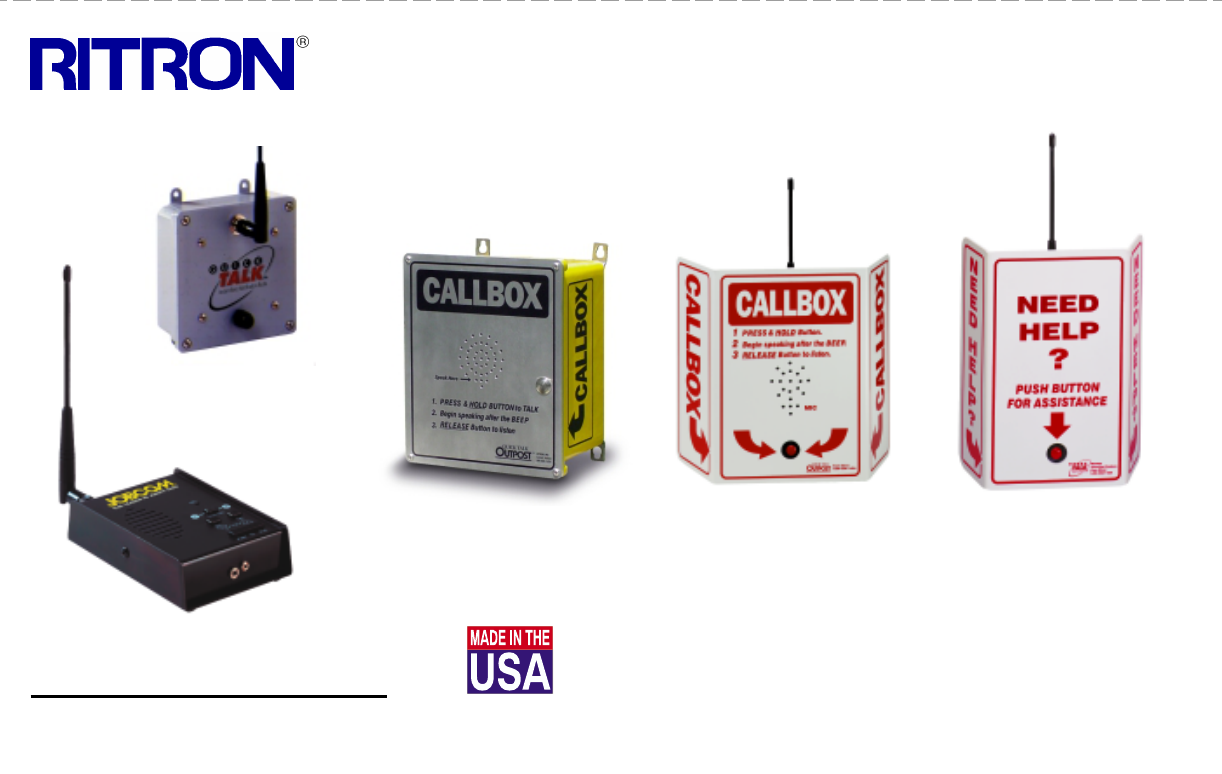
page 3 RITRON, INC. 1-800-USA-1-USA
(1-800-872-1872)
Have questions? Call
800-USA-1-USA
(800-872-1872) or visit our website at www.ritron.com
505 West Carmel Drive
•
Carmel, IN 46032
P. O. Box 1998
• Carmel, IN 46032
Ph: 317-846-1201
•
Fax: 317-846-4978
•
Email: ritron@ritron.com
Website: www.ritron.com
Pub. 14500036 REV. A 03-02
COPYRIGHT© 2003 RITRON, INC. • ALL RIGHTS RESERVED
RITRON®, JOBCOM® , and QUIET CALL® ARE REGISTERED TRADEMARKS OF RITRON, INC.
Quick Talk TM Alert
for Remote Monitoring
of any sensor or switch
Wireless Intercom/Base Station
Desktop or Wall Mountable Radio
Quick Talk OutPost TM XT
Ruggedized Two-Way Callbox Quick Talk OutPost TM
Basic Two-Way Callbox Quick Assist
®
Push-Button RF Transmitter
Designed to work as an integrated system or as an add-on to virtually any existing two-way radio system
Battery-operated callboxes provide instant wireless communication over existing two-way radio systems
14500036_030303.p65 4/14/03, 3:35 PM20